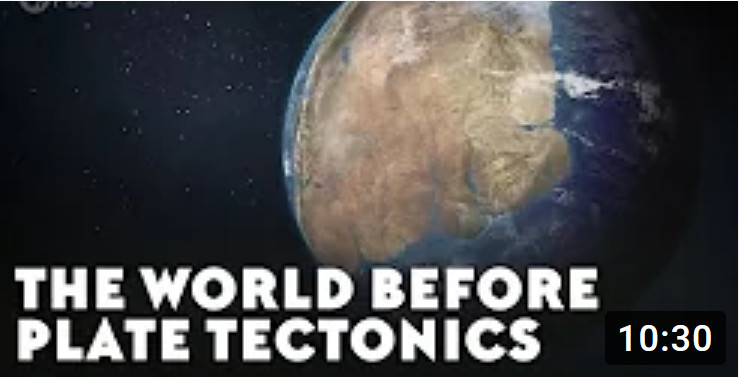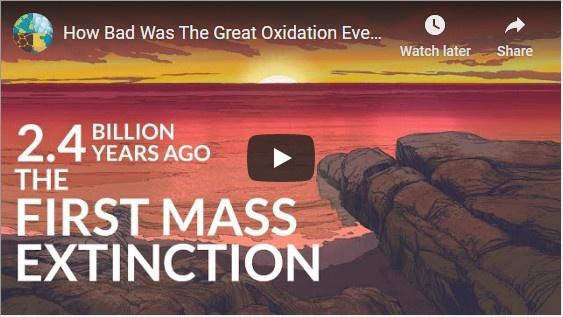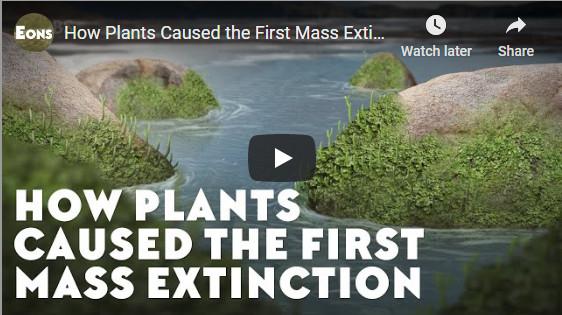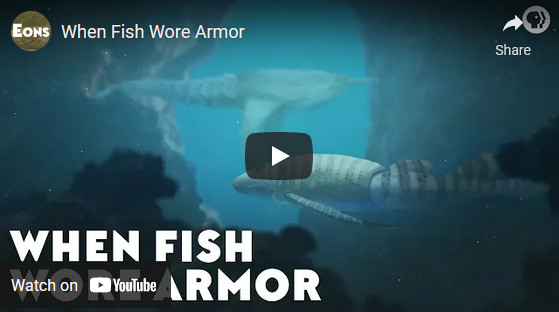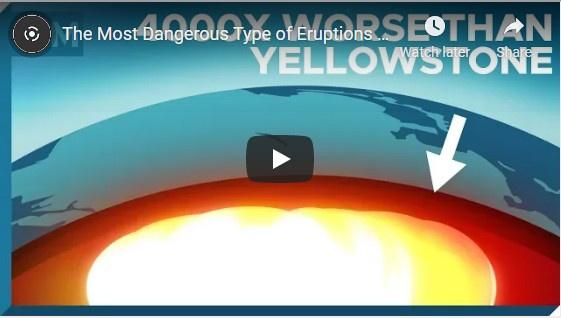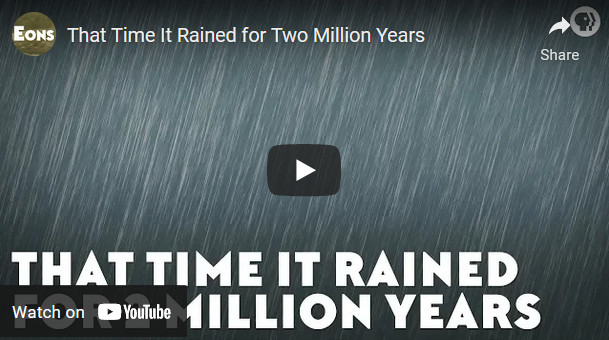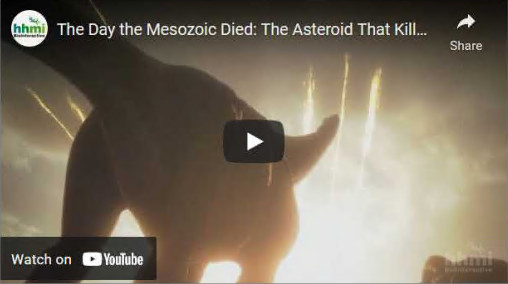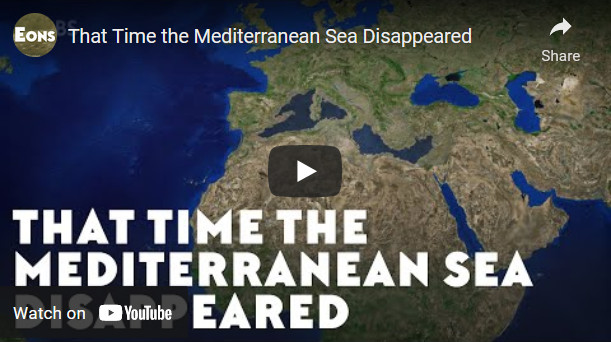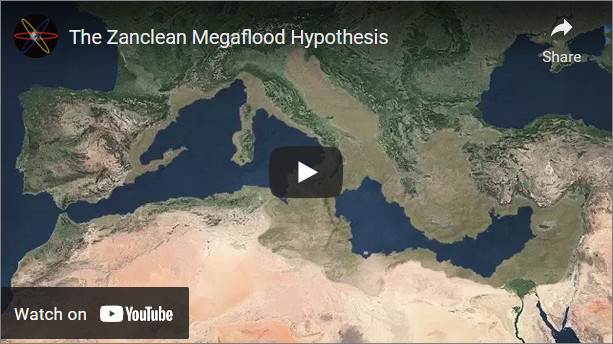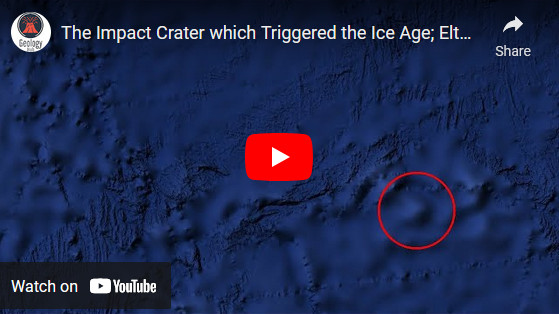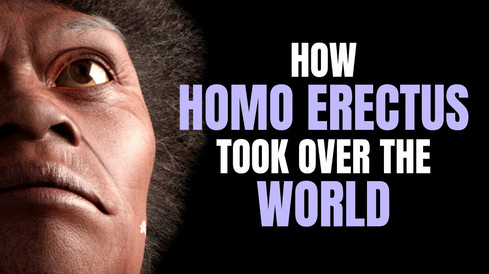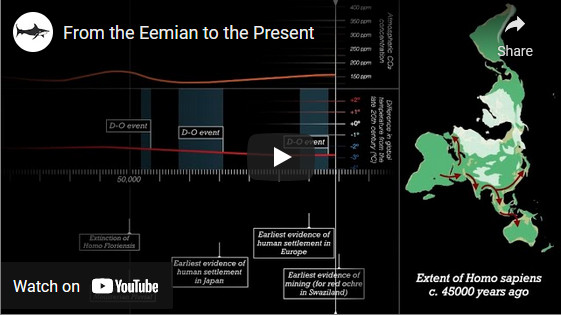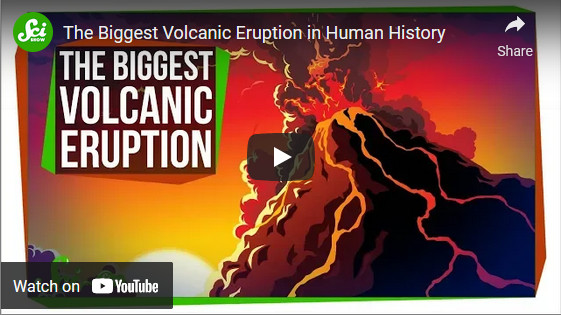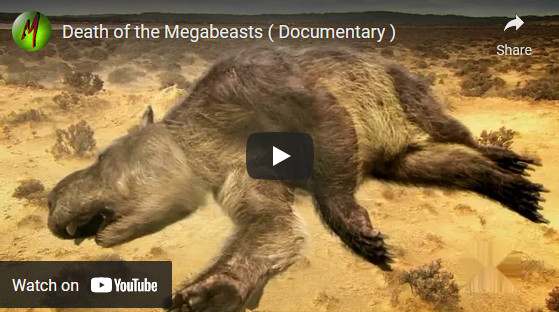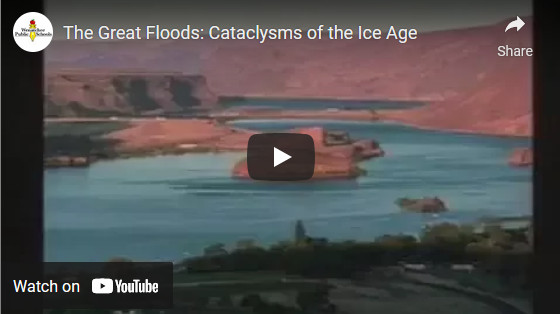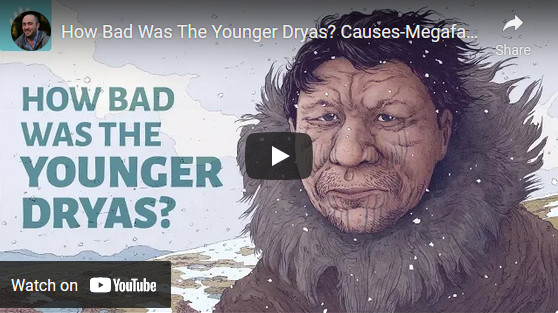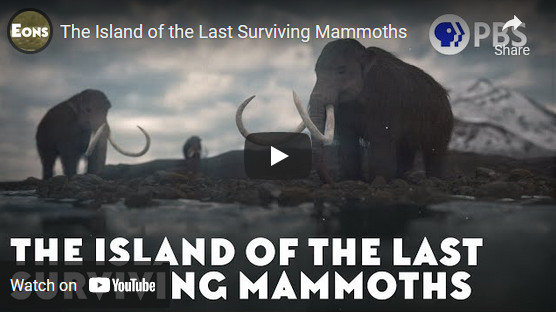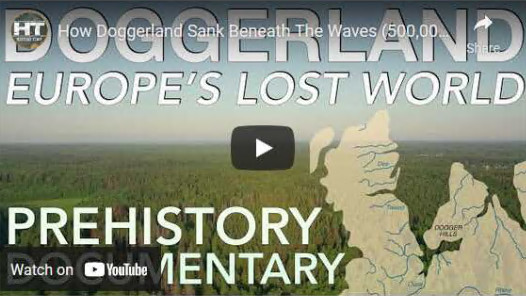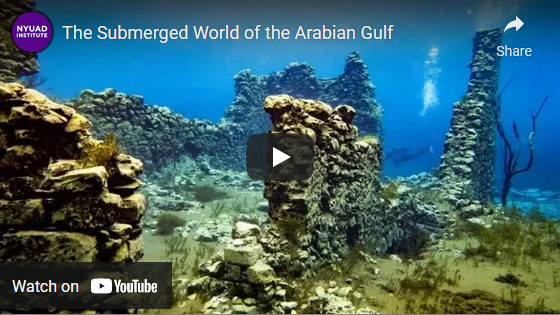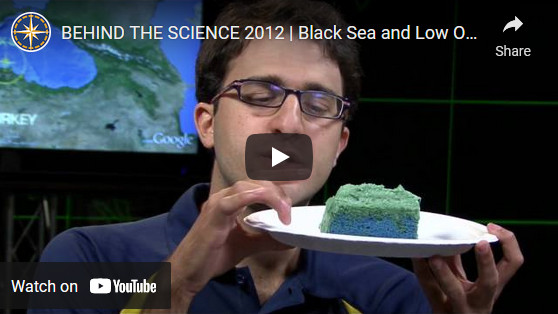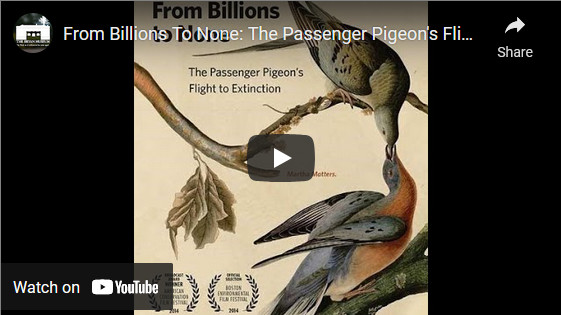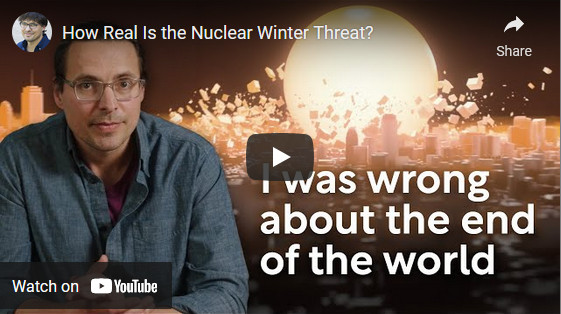List of extinction events
This List of extinction events is a section of the "Why are we here?", an exercise of exploration that I'm also carrying out on my blog. The study of the ancestral fight between Life versus Extinction was originally a part of the chapter "The spark of Life - 500 million years ago to 2 million years ago" in the above article, but after a while I realised that this "List of extinction events" exploration was causing the Spark of Life chapter to be extremely huge, so I decided for the sake of simplicity to have it on a separated thread. This also facilitates the reading, analysis and focus on this crucial matter of the dance between Life and its antagonistic nemesis Extinction over the surface of our planet. Note that Death if not the opposite of Life...Death is actually part of Life but Extinction....that is the end of the game indeed for the species affected
Of all the species that have ever inhabited planet Earth, 95% of them are gone. It is like going to a party that you know is happening at your local club between 7pm and 9pm, and find that only 4 people are there out of the nearly 100 that you were expecting, pretty lame ah? Science summarised in only 5 mayor mass extinctions, each one of them associated to a notorious disaster, but I've added a few more which I think are relevant. Anything that changes the environment quickly, inevitable lead to a extinction because species are unable to adapt or evolve. However, extinctions do not necessary happens because of events (meteor impacts, climate change, massive volcanic eruptions, etc) but also because of 'normal' circumstances in the bumpy road of Evolution of our planet, like some species simply dying out as if t their time to fade away has arrived. Each species has an average life span of roughly 5 million years, so when that time come, DNA degradation may occur and the species will simply vanished back into the carbon cycle into what is call by Biologist mutational meltdown. We are all interconnected, and when a species disappear they don't go alone, other species always follow them, thus creating a mass extinction event, or minor depending on the number of species that are wiped out
This is the list of extinctions events that I have enumerated, for each one of them I've included a few pictures of some of the creatures that are no longer with us (a maximum of 21 pictures and one video if relevant, otherwise I go crazy). The dates for some of the events are always in dispute, so apologies to all palaeontologists and geo-palaeontologists if I've made any mistakes, more than happy to receive comments to improve this "List of Extinction events" article or emails! My email is on the Profile >> About me page
- Extinction 1 - (3.8 Gya) Archean Eon and the Carbon Genesis
- Extinction 2 - (2.4 Gya) Huronian Glaciation, Snowball Earth 1 - Great Oxygenation Event (GOE) - First major Ice Age
- Extinction 3 - (650 Mya) Stuartian Glaciation, Snowball Earth 2 - Second Ice Age
- Extinction 4 - (542 Mya) End-Ediacaran Extinction
- Extinction 5 - (513-517 Mya) End-Botomian Extinction
- Extinction 6 - (502-497 Mya) Dresbachian Extinction
- Extinction 7 - (488 Mya) Cambrian-Ordovician Extinction
- Extinction 8 - (450 Mya) 86% of species lost: (1) Ordovician-Silurian Extinction
- Extinction 9 - (428 Mya) Ireviken event
- Extinction 10 - (424 Mya) Mulde event
- Extinction 11 - (420 Mya) Lau event
- Extinction 12 - (375 Mya) 86% of species lost: (2) Late Devonian Extinction episode
- Extinction 13 - (305 Mya) Carboniferous Rainforest Collapse
- Extinction 14 - (272 Mya) Olson's Extinction
- Extinction 15 - (260 Mya) End-Capitanian extinction event
- Extinction 16 - (250 Mya) 96% of species lost: (3) The Great Permian Extinction
- Extinction 17 - (232 Mya) The Carnian Pluvial Episode (CPE)
- Extinction 18 - (200 Mya) 80% of species lost: (4) End of Triassic Extinction
- Extinction 19 - (183 Mya) Toarcian turnover
- Extinction 20 - (145 Mya) End-Jurassic (Tithonian) extinction
- Extinction 21 - (117 Mya) Aptian Extinction
- Extinction 22 - (94 Mya) Cenomanian-Turonian boundary event
- Extinction 23 - (66 Mya) 76% of species lost: (5) End of Cretaceous and the Dinosaurs
- Extinction 24 - (56 Mya) Paleocene-Eocene Thermal Maximum (PETM)
- Extinction 25 - (33.9 Mya) Eocene–Oligocene Transition event (EOT)
- Extinction 26 - (16.9 Mya) Mid Miocene Climate Optimum (MMCO)
- Extinction 27 - (14.5 Mya) Middle Miocene disruption
- Extinction 28 - (5.96 Mya) Kapitean-Optian Glacial Event
- Extinction 29 - (5.3 Mya) The Zanclean flood
- Extinction 30 - (3 Mya) The Great American Biotic Interchange
- Extinction 31 - (2.6 Mya) Pliocene–Pleistocene boundary extinction
- Extinction 32 - (1.09 Mya) The Gakkel Ridge Caldera
- Extinction 32 - (400,000) The Homo species extinctions and fire
- Extinction 33 - (130,000 years ago) The Eemian interglacial
- Extinction 34 - (74,000 years go) The Toba eruption
- Extinction 35 - (46,000 years ago) Quaternary extinction, Australian Megafauna disappearance
- Campanian Ignimbrite eruption (39,000 years ago)
- Oruanui eruption (26.50 years ago)
- Extinction 36 - (14,000 years ago) Quaternary extinction, North America Megafauna disappearance
- Extinction 37 - (13,000 years ago) Lake Missoula drainage
- Extinction 38 - (12,000 years ago) The Younger Dryas
- The Sundaland Submerge (11,500 years ago)
- Extinction 39 - (11,000 years ago) Quaternary extinction, South America Megafauna disappearance
- Extinction 40 - (10,000 years ago) Quaternary extinction, Eurasia Megafauna disappearance
- Extinction 41 - (8,200 years ago) The sinking of Doggerland
- The collapse of Lake Agassiz
- Extinction 42 - (8,000 years ago) The flooding of the Persian Gulf basin
- Extinction 43 - (7,600 years ago) The Black Sea deluge
- List of cosmic impacts (asteroids, comets and meteors) potentially related to extinction events
- List of volcanic eruptions (flood basalt and Large Igneous Provinces) potentially related to extinction events
- Extinction 44 - (ongoing) predicted 80% of species lost: (6) Holocene Extinction
- Extinction Imminent
- Extinction Futura
- Extinction Finale
Extinction 1 - (3.8 Gya) Archean Eon and the Carbon Genesis
"Life as we know it" means carbon-base Life, our genesis is formally known as Abiogenesis, but there might have been other genesis in our planet. In fact, nowadays Life exist in places where our current biochemistry cannot survive, places full of methane (CH4) and carbon dioxide (CO2), gases that were in our atmosphere in the Archean Eon, long before the arrival of oxygen (O2). When cyanobacteria developed 3.8 billion years ago and started harvesting sunlight, they slowly began polluting the atmosphere with oxygen, and many species of bacteria that could not take oxygen in were force to evolve or die. There is a potential extinction event here, that we should recognised, when the Genesis-Photosynthesis bacteria from which we all descend killed all other entities that might have existed in our planet when it atmosphere was full of carbon dioxide. Who is not to say that the whole surface of the planet and its rivers, rich in iron and methane, were not covered in snottite and other similar bacteria? Had they had the chance to evolve into something else... what that something else would have been? Okay, that 'something else' might not have been as powerful as we are, organisms who use the rich-energy fuel of oxygen, but still, who knows what creatures could have developed if that bacteria had had time to evolve?
There are still a few survivors of this primitive extinction, cause by an intense oxygenation of the atmosphere, hidden in toxic caves, that might belong to other Genesis and don't need oxygen at all to make a living. This kind of bacteria, the survivors, are called extremophile and their existence challenge the idea that there was a unique Genesis or formation of Life. Life indeed needs water as a lubricant and as the main transportation of nutrients around the living body, and of course an external source of energy, together with carbon: all living organisms known to men are carbon-based, and every single molecule that we know of uses carbon as its backbone for its biological processes, but that's about it: there is no need of oxygen for Life to exist
References
- https://www.geosociety.org/GSA/Education_Careers/Geologic_Time_Scale/GSA/timescale/home.aspx
- https://www.wikiwand.com/en/Geological_history_of_Earth
- https://tok.fandom.com/wiki/List_of_extinction_events
- https://bitesizebio.com/2462/how-thermophile-dna-survives/
Extinction 2 - (2.4 Gya) Huronian Glaciation, Snowball Earth 1 - Great Oxygenation Event (GOE) - First major Ice Age
The creation of photosynthesis has been pointed out has the root cause of the first global planet glaciation, the first Snowball event. During the Photosynthesis process, bacteria absorb green house gases from the atmosphere, CO2, thus cooling their environment. The bacteria, using primitive photosynthesis, were effectively removing green house gases like methane from the atmosphere and replacing it with oxygen, cooling the planet at first NOT because there was a huge amount of oxygen on it, but because they removed all of the greenhouse gases, reaching a minimum Cold-GFI index. To make things worse, the super-continent Kenorland began to break up altering the weather pattern, separating land masses which, being surrounded by oceans, retained less heat in their interior, causing all these circumstances the Huronian Glaciation that was to last for 300 million years...think about it.... that's longer than the period of dinosaurs ever roamed the Earth. In theory, after the super-continent Kernorland broke apart in plates, another super-continent began to form: the super-continent Nuna, also called Columbia or Hudsoland, which proves that if you wait long enough everything changes, not even the bedrock remains intact
So, how many types of bacteria died during that glaciation? Sea levels dropped, all water became ice and therefore no rain. This event is know as the Great Oxygenation Event (GOE) and it took million of years to develop, rusting planet Earth and creating in the process rich-iron rock that, an unimaginable amount of time after, will be used by an advanced civilization to power its Industrial Revolution. The Great Oxygenation Event was a a suicide for bacteria, who could not cope with the waste product (Oxygen) that they were pumping into the atmosphere. Out of CO2, the planet began a glaciation which then eventually stopped (but not to a halt) because there was not enough bacteria left to continue the oxygenation process of the planet. Bacteria must have died by the trillions, because no more CO2 was removed from the oceans or from the atmosphere. Incidentally, around this time bacteria had evolved and adapted themselves to deal with the toxic Oxygen they themselves were generating. Eventually, a few volcanic eruptions might have been what was needed to slowly warm up the planet again, pumping CO2 and green houses into the atmosphere and ended this gigantic glaciation; even a small amount of eruptions and CO2 would have done it, as there was literally no process in place to remove any CO2 pumped into the atmosphere, so the planet slowly got warmer and Snowball Earth part 1 ended... though not for long
More research is needed regarding this epoch of our planet, called the "Boring Billion" by pantheologies, with Life making very little progress from the biology point of view, as it turns out that bacteria need a lot of time to geo-transform a planet. This heavy glaciation early in the history of our planet could also be due to the Faint Young Sun Paradox, and issue proposed by Carl Sagan and George Mullen by which, they argue, the Earth must have been frozen over early in its history because the Sun was 30% less brighter and therefore less heat arrived to Earth. However, we ought to consider that early on its history our planet had lots of energy on the surface emanating from the core, remnants of the collusion it experienced with Theia, a proto-planet that smashed into Earth and that I studied in the section "The kiss of Theia - 4.5 billion years ago", also on my blog. Our Moon was very closed to our planet, creating intense frictions (huge storms and massive tides must have been normal) that prevented our planet from entering into a Snowball Earth early on its history
In summary, it took a billion years for bacteria to geo-transform our planet, pumping O2 into it first on the layers on the ocean floor, creating rust, and then going all the way up to the atmosphere. The abundance of Oxygen at the end of the Great Oxygenation Event present the perfect scenario for "fire" to manifest. We should understand that fire, the chemical process by which"fuel + O2 + heat" generates H2O + CO2 + Light + Heat, is a unique process to our planet. No other planet in the known Universe is known to have fire, and fire is so crucial for life
Impacts crates also have to be taken into account. Meteors, Asteroids and Comets impacts can be indeed catastrophic and deliver a huge amount of energy to the surface of the planet, releasing heat and vaporised rock to the atmosphere, causing gigantic earthquakes and possible lava moves and eventual volcanic eruptions that can all contribute to a significant pumping of CO2, methane and greenhouse gases into the atmosphere, creating this, after the few initial weeks/months of hell on earth, a drop in temperatures as direct sunlight gets blocked and it cannot warm up the surface (nuclear winter), but thereafter, when the thick clouds disappear, the greenhouse gases will trap any heat coming from the sun (nuclear summer) and thus heating up the planet gradually. Copenircus crater, in the Moon, in which inside the M25 London motorway fits almost perfectly, was created 800 million years ago. The following are ancient impacts craters that could have contributed to the end of the glaciation:
1) Yarrabubba crater; dated 2.229 billion years ago (70 km diameter), it is the oldest crater found in our planet, the Yarrabubba crater is located in south-west Australia, could have been a contributor to the end of this glaciation, smashing through the ice crust of Snowball earth 1, hitting a key point in the continental plates and perhaps creating a shock wave powerful enough to wake up a few volcanos that eventually pumped enough CO2 into our atmosphere for the meltdown to start
2) Vredefort crater; dated 2.023 billion years ago (300 km diameter), the same could be said regarding the second oldest known crater, the gigantic Vredefort crater, in South Africa, the largest single-asteroid verified impact on our planet and that is dated around 2 billions years
3) Sudbury basin crater; dated 1.849 billions years ago (250 km diameter), unlike other impacts, the now totally eroded crater of Sudbury Basin, in Canada, must have been created not by a direct impact but by the gigantic shock-wave of a comet that exploded in the atmosphere, hence its elliptical shape and the nature of the geological composition of the rocks found in the crater. Absolutely fascinating that is
References
- https://www.techradar.com/uk/news/these-two-ancient-supermountains-may-be-responsible-for-evolution-of-life-on-earth
- https://upload.wikimedia.org/wikipedia/commons/c/cc/Earth_Impact_Database_world_map.svg
- https://all-geo.org/erratics/2011/03/impacts-and-geology-deep-peace/
- https://astrobiology.nasa.gov/news/nasa-determines-australian-meteor-crater-is-the-oldest-known/
Extinction 3 - (650 Mya) Stuartian Glaciation, Snowball Earth 2 - Second Ice Age
So the planet stay frozen for nearly 300 million years during Snowball 1, and insane amount of time for our brains, but then warm up again and the bacteria began to spread again, depleting the atmosphere of greenhouse gases... again... and causing, you guess it: Glaciation Snowball Earth 2, also called Stuart-Varangian Glaciation or Cryogenian Glaciation, the time our planet has been the coldest, with average estimated temperatures of -20 degrees Celcius at the equator. This time there is plenty evidence for this event. There is a BIG, BIG jump of time between snowball events of almost 2 billions years... the time it took bacteria to remove CO2 from the atmosphere and the volcanism of the planet to restore it back again. Glacial Erratics, the rocks left after a glacier is melt, are a clear indication of Snowball events. These sort of erratic rocks are found in Flinders Ranges (Australia) or Death Valley (USA), given evidence for Snowball Earth 2, where the magnetic signature of the rocks shows they were in the tropics... so how can a glacier exist in the Equator? Well.... there you have the Kilimanjaro glacial. The "weathering process" takes away CO2 from the atmosphere and lock it away, furthermore, cyanobacteria generates oxygen so they make things even worse, locking CO2 into stromatolites. That creates more ice (specially sea ice, that reflects 85% of the sunlight it hits it) , which in turn reflects even more sunlight away, thus starting a run away process that cools the Earth to a no return of freeze point that lasted for million of years
The newly formed super-continent Rodinia was located mostly at the Equator, which produces a higher albedo than oceans (continents, when covered with ice, reflect more sunlight than oceans, which initially are hard to freeze unless close to landmasses) causing the planet to absorb less heat in its atmosphere and cooling Earth. It is argue that snowball Earth started when the Rodinia began to break apart, changing the weather pattern with the formation of rivers that increased the nutrients in the oceans, causing this more bacteria to suck CO2 from the atmosphere and replace it with Oxygen, thus cooling the planet further.....looks like it took a long time to fine that cute balance that we have now in our atmosphere of CO2 versus Oxygen, and I just can't help thinking: no matter how much CO2 bacteria were able to remove from the atmosphere, surely a few volcanic eruptions of our much violent ancient Earth would have been enough to replace the missing gasses, so why the planet froze to the point of no return? Young Sun Paradox? Could it happen again? During this period the Marinoan Glaciation also occurred around 635 Mya, and though shorter than the Sturtian Glaciation (only...ehem..30 millions years, kind of 'short' for geological terms, but just imagine how long is that length of time), it could have also caused a Snowball effect, that would have been list of extinction events Snowball Earth 3
But, could this frozen event had been caused by an inclination of Earth orbit or something similar? Apparently, the Earth orbit goes in cycles of 100,000 years or so, where it goes to an extreme elliptic orbit that causes a deep freeze, though this is happening now, back 650 Mya the Moon was much closer to Earth and the orbit parameters of our planet may have been much different than today. We know that big eruptions trigger cooler period on Earth, because the ashes create a blanket that prevent heat from coming into the planet (nuclear winter). So how can that massive eruptions like the Siberian trap,s which happened later, did not cause a snowball event? The key could be the amount of sulphur dioxide (SO2) emitted by the eruption, the more this gas the worse: it interacts with water high in the atmosphere and reflects sunlight, plus it triggers acid rain, what a joy for a lovely gas! No wonder it is related to the perfume of hell
The snowball event triggered the development of complex life (metazoan), perhaps by boosting the levels of phosphate (PO43-) and nutrients in the oceans once the glacials melted: only 3 Mya after the Gaskiers glaciation ended 582 Mya, our planet earth had a massive explosion of life from bacteria into the first multicellular organism, known as the Avalon Explosion, a key point to this evolution was the amount of oxygen present in deeper and deeper waters, not just shallow oceans
4) Beaverhead crater; dated 600 Mya (100 km), located in Idaho, US, and pretty close to Yellowstone park, this impact is very eroded by tectonic plates movements, buy hey, with a diameter of at least 100 kms, it must have caused havoc back on the day when it landed
5) Acraman crater; dated 580 Mya (90 km diameter), is located in South Australia; this impact happened during this epoch, so... did it contribute to speed up the warming process of the planet?
References
- https://phys.org/news/2018-05-earth-frozen-solid.html
- https://someinterestingfacts.net/kenorland-rodinia-and-pangaea/
- https://www.snowballearth.org/cause.html
- https://craterexplorer.ca/beaverhead-impact-structure/
Extinction 4 - (542 Mya) End-Ediacaran Extinction
In our list of extinction events, this is the first known biological extinction event, where fossils show an abundance of macroscopic (visible to the naked eye) life on our oceans 575 millions years ago, creatures (they were not animals or plants yet) that drastically declined 24 million years after, thus indicating an extinction event that is called the End-Ediacaran Extinction. It is still a mystery what caused this extinction, the unconfirmed Massive Pre-Cambrian Impact Structure (MAPCIS), a maximum of 2,000 km outer-ring impact crater in central Australia, has been tentatively dated to this time period. An impact of such astronomical proportions would have been utterly devastating for Life, and triggered an stagnated process in the oceans, depleting them of oxygen and hence contributing massively to this extinction event. At that time, the super-continent Pannotia existed, with Australia, where MAPCIS hit, positioned around the equator of planet Earth
A significant creature that got extinct during this period was the Dickinsonia, one of the first complex creatures to have ever existed. The creatures of the late Ediacaran period were called rangeomorphs, not-plants or not-animals, and grew in fractal-like format, with each branch of the creature being a smaller version of the creature itself....interesting, as if they had an intimate knowledge of algebra. The Fibonacci sequence of reproduction was nowhere to be found yet, only fractal, meaning that the DNA of these creatures was very simple indeed and not aware of complex maths multiplications
It is interesting to note that photosyntheses had already been invented, yet rangeomorphs fed themselves with nutrients floating in the sea. Thanks God sex has already been invented :), but there was no concept of prey and predator, and it is argue as well that the arrival of predators cause the Ediacaran biota to get extinct, when suddenly a new creature had a mutation that allow it to eat another creature, and all Ediacaran biota had no defensive mechanism whatsoever, they were easy target to eat
6) MAPCIS crater; dated 545 Mya (600 km diameter) is a proposed asteroid impact, meaning it is still under study and unconfirmed. If this impact really happened it must have set the clock of Life back, it is a gigantic one! Four times bigger than the crater's meteor that cause the dinosaurs to become extinct
References
- https://en.everybodywiki.com/Massive_Australian_Precambrian/Cambrian_Impact_Structure
- https://www.sciencedaily.com/releases/2018/06/180627160543.htm
Extinction 5 - (513-517 Mya) End-Botomian Extinction
This is also called the Middle Cambrian Extinction and is estimated to have wiped out around 40% of the marine life. By this time, the Cambrian Explosion of Life had already happened, and the oceans were dynamic and full of Life, where biomineralisation had begun and organisms started to build shells
Fossils indicated an extinction event between 513 to 509 Mya, with an estimate decline in global diversity of 40% of marine species. The reason for this extinction are unknown, but again all points out to anoxic oceans due to volcanic eruptions most likely in The Kalkarindji Large Igneous Province, Australia. These eruptions could have poisoned the oceans and lead to a collapse of the phytoplankton, the base of the food chain. Some trilobites species were already living around this time, meaning that the concept of prey and predator was well established and animals ate one another (trilobites had a hard carcase to protect their softly parts from predators)
References
- https://www.newscientist.com/article/mg13518322-900-science-the-biggest-mass-extinction-of-them-all/
- https://www.sci.news/paleontology/hyoliths-cambrian-lophophorates-04531.html
Extinction 6 - (502-497 Mya) Dresbachian Extinction
This is also called the Upper Cambrian Extinction, and is estimated to have decimated 40% of marine life. During the Cambrian period Life existed only in the oceans
The Dresbachian extinction in our list of extinction events is one of the most poorly documented entries in our list of extinction events, due to the lack of fossils so far back in the history of Life on our planet
Extinction 7 - (488 Mya) Cambrian-Ordovician Extinction
This extinction marks the end of the Cambrian period and the beginning of the Ordovician
The reason/s for this extinction are not well understood by Science, but definitely it had something to do with the levels of oxygen in the oceans, they dropped and a lack of oxygen combined with Hydrogen sulphide (H2S), the so-called "rotten egg" gas (it has been detected in many rocks dated around this time), may have surely killed many species. All these animals during the Cambrian period were either predators or prey, or both. To survive, you either have to be an apex predator like Anomalocaris, run fast and don't get caught, or develop a shell or armour so you don't get eaten easily. The most plausible causes for this extinction are:
Glacial cooling hypothesis; a change in climate, driven perhaps by the formation of the super-continent Gondwana, cause ice to form in land masses, with the consequence sea levels to drop, cooling the oceans and reducing the amount of shallow seas, thus killing most of the Cambrian fauna that were adapted to live in warm waters
Oxygen depletion hypothesis; something massive happened in the food chain that caused either algae or bacteria to stagnate the oceans, it could also have been underwater volcanos but to cause such extinction must have been huge. All these resulted in rotten oceans and a positive feedback loop of more animals dying and decomposing in the oceans, removing even more oxygen from it and replacing it with hydrogen sulphide
These are some of the species that were extinct during this event:
References
- https://park.org/Canada/Museum/extinction/camcause.html
- https://www.sci.news/paleontology/science-hallucigenia-cambrian-worm-like-creature-02949.html
- https://scitechdaily.com/coronacollina-acula-oldest-organism-with-skeleton-discovered/
Extinction 8 - (450 Mya) 86% of species lost: (1) Ordovician-Silurian Extinction
This is also called the Late Ordovician Mass Extinction (LOME). Up to this point Life was mostly restricted to the oceans, and though since the Archean period bacteria had been living in dump areas of rivers, lakes, etc, it was in the form of tiny lichen and green algae, that slowly were colonising coastal areas where their "cryptogamic cover" was breaking down the minerals from rocks and further enriching the oceans with nutrients like phosphorous. All of these early plants were still much dependable of the water nearby, unable to extend further inland into dry areas.....yet. It is argue that the proliferation of plants in dry areas created an "algae bloom" that depleted the oceans from oxygen, thus leading to this extinction
The creation of the Appalachian Mountain range, that were to be our current Himalayas for many million of years to come, could have been a contributor also to this extinction event, as they will likely have changed weather patterns, causing a glaciation of the continent Gondwana and dropping sea levels worldwide, leading to a "first pulse of extinction". Thereafter, a warming of the climate caused a "second pulse of extinction" that lead to many species being lost
Fossils from that epoch shows deformities, as if affected by high level of heavy metals, in particular toxic metals like mercury, perhaps caused by underwater massive volcanic eruptions. Rapid global cooling and sea level drop, with a sudden warm of the climate afterwards, were the main factors for this mass extinction, but what caused all of this? Science has yet to find the root cause. It is theorised, thou, that a gigantic volcanic eruption that took place approximately 452 Mya ago, the Millbrig eruptions in what it is now the Atlantic Ocean, could have been a contributor
7) Clearwater East Lake crater; dated 460 Mya (26 km); with a diameter of just over 25 km, this impact qualifies to my personal list of meteor residents on our planet. Given the fact it may have occurred 10 million years before this extinction, it may not have had an impact in the Ordovician-Silurian list of extinction events, but it is a very interesting impact when we consider that, roughly 175 million years after, another asteroid (mentioned in Extinction 13 entry) will impact our planet....in the same location!! What are the odds of that happening?
References
- https://www.discovermagazine.com/planet-earth/the-ordovician-extinction-our-planets-first-brush-with-death
- https://en.wikipedia.org/wiki/Gamma-ray_burst#Hypothetical_effects_on_Earth_in_the_past
- https://eos.org/articles/tiny-algae-may-have-prompted-a-mass-extinction
- https://www.sepm.org/files/24article.5bgzn442hichl4um.pdf
- https://craterexplorer.ca/clearwater-east-impact-crater/
Extinction 9 - (428 Mya) Ireviken event
This was an event that occurred in the middle of the Silurian era, and though by our current standards we usually understand as "event" a situation that happens from beginning to end within a limited amount of time, a few minutes or so, due to the large scale of time that we are talking about here, this "event" of the Ireviken extinction lasted for around 200,000 thousands years
The event has been best preserved at a location called Ireviken, in the island of Gotland (Sweden), where fossils show that over 50% of trilobite species became extinct, with 80% of the global conodont species also becoming extinct during this interval. Again, deep-ocean anoxia seems to have caused all of this. Could there be a relation between this event and a glaciation triggered by the Milankovitch cycles? Possibly not, around this time the Moon was much closer to Earth than it is today, meaning the parameters that cause the Milankovitch cycles may have been different due to a stronger gravity presence of the Moon
References
Extinction 10 - (424 Mya) Mulde event
This is the second of the three "minor" extinction events that happened during the Silurian period. It coincided with a drop in sea level worldwide, which probably caused anoxia in the waters and hence the dying of creatures. During this period the oceans did not have the oceanic currents (Ocean Conveyor Belt or Thermohaline circulation) that we enjoy nowadays and that helps oxygenate the waters
References
- https://www.grunge.com/728628/every-mass-extinction-event-explained/
- https://e-docs.geo-leo.de/bitstream/handle/11858/7064/1-s2.0-S1674987117300294-main.pdf
Extinction 11 - (420 Mya) Lau event
The Lau event was the last of the three relatively "minor" extinctions during the Silurian period. This entry in the list of extinction events is estimated to have killed a great number of marine life, up to 85% of it. Again, it seems to have been caused by anoxia in the oceans, in other words lack of oxygen in the waters, but why did that happen? Nobody knows
400 millions years ago, a day was just 21 hours long
Extinction 12 - (375 Mya) 86% of species lost : (2) Late Devonian Extinction episode
In the list of extinction events, the Late Devonian is the second great extinction that happened in the oceans, putting an end to the "Age of Fishes". Fossil records indicate that proto-plants and proto-insects (arthropods) were already colonising the land, meaning that creatures that were almost amphibians began to move inland too, surely to feast on those juice proto-insects that had no predator. Another reason to move away from the waters was that the oceans were by now crowded with gigantic apex predators like the Dunkleosteus, whose bite was strong enough to break the armour plate many fishes wore at this time. During the Devonian, photosynthesis took place only at a maximum depth of 50 meters below sea level, while nowadays happens up to 500 meters below sea level, meaning that life most mostly concentrated on the first 50 meters of the oceans and only around coastal areas
There is evidence of fire around this time, when geologies found spores of Prototaxites, the gigantic fungus, burn to the core. It is believe that the Prototaxites, raising up to 8 or 9 meters, will have attracted lighting, thus cause the first wild-fires ever
This extinction episode happened over a long period of time, something between 25 to 30 millions years, in what it is considered to be a prolong interval of biodiversity decline, which comprises between 3 to 7 different pulses of extinction events, some of these events were:
a) Kellwasser event, 372 Mya, caused by the eruption of the then Frasnian-Famennian LIP (Large Igneous Province), in Europe, but due to the huge amount of time involved, it is hard to be certain about this and is all open to speculation and of course further investigation
b) Hangenberg crisis, 359 Mya, caused by a rapid sea level drop perhaps due to glaciation, hence leading to an anoxic in the oceans (lack of oxygen, which obviously kill wild life but preserve their bodies); a sediment of black shale marks this event
The coral reefs receded and they never recovered and flourished like they did on the Devonian. The continents Euramerica-Laurussia-Laurentia and Gondwana were merging in what it would be the super-continent Pangea that is characterise by the Central Pangean mountains in the middle. Other causes that could have contributed to this extinction episode are these:
c) SuperNova explosion nearby; if a dying-star were to go supernova within 25 light years of us (the so-called killing distance), the explosion will wipe out the ozone layer, allowing gamma rays to hit the surface and damaging all DNA of living creatures. Plant spore fossils of this epoch suggest they were burn by ultraviolet light, as if this sort of event happened in the backyard on our galaxy
d) Eutrophication events; also called "algae blooms", eutrophication is the process of when waters become enriched with minerals and nutrients that cause anoxic; this could have happened during the Late Devonian in particular as the first forests appeared and the weathering process increased (weathering is the process by which plants break down rocks and extracts from them minerals like phosphorous, silicates and nitrogen)
e) Carberean Cauldron; is a supervolcano caldera which erupted 374 Mya; it is now Lake Eildon National Park in south Australia, close to Melbourne
f) The Vilyuy Traps eruption; located in Eastern Siberia, have thought to have erupted 373 Mya
And indeed, we also need to consider the following extraterrestrial impacts as causes for extinction pulse events:
8) Siljan Ring; dated 376 Mya (52 km diameter), located in the middle of Sweden
9) Woodleigh crater; dated 364 Mya (60 km diameter), located in western Australia
References
- https://www.miguasha.ca/mig-en/miguasha_fossils_around_the_world.php
- https://mikeallsop.wixsite.com/soilfungi/fungi
- https://hydra.hull.ac.uk/assets/hull:10877/content
- https://www.nature.com/articles/s41598-018-27847-7
Extinction 13 - (305 Mya) Carboniferous Rainforest Collapse
During the Carboniferous, Life was thoroughly established and in full motion in our planet. The slow collision of the continents Laurasia and Gondwana that were to form the Central Pangean Mountains (Appalachian and Variscan mountains) facilitated an unique ecosystem. Vast areas were covered in tropical forests and swamps, whose remain are the coal that we "enjoy" nowadays (dead trees were making sediments at an estimated rate of around a millimetre per year), being these jungles full of arthropods, insects and amphibians that were co-evolving at the same time that plants were evolving too. Nova Scotia is without doubt the best place to study the Carboniferous
Oxygen levels raised to their highest during the Carboniferous period, at 35% (compared to 21% that we have today) causing the size of insects to increase to gigantic proportions as they breathe through their 'skin'. Some of these insects may have been wiped out during the Carboniferous Rainforest Collapse (CRC), the minor extinction event that occurred around 305 Mya and that affected mostly to plants with the creation of fragmented forest that pushed the amphibious to live far away from water. These amphibious developed what is called Amniotes eggs, eggs with a hard shell that helps the embryo retain water and nutrients, a significant step in evolution
During this extinction, we have to consider too the following extraterrestrial impacts:
10) West and East Warburton Basins; dated sometime between 300 to 360 Mya (400 km diameter), located again in our beloved Australia, this is the largest impact area found in our planet, when a gigantic asteroid split and entered our atmosphere in 2 parts of more of 10km each. Just for comparison, the one that wipe the dynos had 12 km...just imagine the devastation that 2 asteroids of 10km each would have caused at the same time. Shocked quartz has been found in this area of Australia, indicating huge pressures that can only be obtained during an asteroid impact. Due to the precise dating for the yet-to-be-confirmed impact, some scientists are not convinced that this double-punch collision would had had any effect on this entry in our list of extinction events, yet something has to explain these basins formations in Australia as well as the root caused for the Carboniferous Rainforest Collapse
11) Clearwater West Lake crater; dated 290 Mya (diameter of 36 km); this is the second crater of a previous impact that slammed on our planet 460 Mya (mentioned in Extinction 8 entry). These two craters located in north-west Canada are absolutely extraordinary....is it a coincidence that two asteroids impacted our Earth at the same location? I think that is amazing, the fact that this thing has happened when we consider that everything rotates in the Cosmos
References
- https://www.sci.news/geology/science-warburton-giant-asteroid-impact-basin-australia-02627.html
- https://www.ranker.com/list/meganeura-giant-prehistoric-dragonfly/genevieve-carlton
- https://lewisrhystwiby.wordpress.com/2021/09/12/paleo-profiles-arthropleura/
- https://www.seeker.com/earth-conservation/prehistoric-rainforest-collapse-dramatically-changed-the-course-of-evolution
- https://commondescentpodcast.wordpress.com/2020/09/05/episode-95-the-carboniferous-rainforest-collapsea/
- https://www.utoronto.ca/news/pei-fossil-sheds-new-light-evolution-reptiles-u-t-paleontologist-0
- https://www.space.com/28822-double-crater-two-asteroid-impacts.html
Extinction 14 - (272 Mya) Olson's Extinction
This extinction event is also called Olson's gap, and it comes to existence as an indication in the fossil record during the early Permian period, which points out to a drastic reduction of the fauna including plants, tetrapods and marine invertebrates. Climate change seems to have been the culprit for this extinction in our list of extinction events. We don't know yet what caused that climate change, though it seems the continental drifting of the continents Euramerican and Gondwana would have had a significant impact
The famous Dimetrodon, of the Synapsids family, and from which humans are descendent, most likely went extinct during this event. May kids have it as a toy together with the dinosaurs, but is a totally different family, wiped out from our planet million of years before dinosaurs became popular on the forests
References
- https://commonreader.wustl.edu/c/a-botanical-pompeii-beneath-our-feet/
- https://www.discovermagazine.com/planet-earth/olsons-extinction-the-permians-dirty-little-secret-die-off
- https://www.cbc.ca/news/canada/prince-edward-island/pei-fossil-footprints-discovered-cavendish-park-1.5027811
Extinction 15 - (260 Mya) End-Capitanian extinction event
The fossil records (again) indicate a period of decreased species and lack of richness in diversity of fauna, which points out to another extinction event that occurred during the Guadalupian epoch (named after the Guadalupe Mountains in New Mexico), in the middle of the Permian. The cause of this extinction event could have been the volcanic eruption of the Emeishan traps, a large igneous province (LIP) in south-west China
References
- https://www.frontiersin.org/articles/10.3389/feart.2021.631198/full
- https://www.bbc.co.uk/news/science-environment-32397220
- https://www.nationalgeographic.co.uk/environment-and-conservation/2019/12/earth-has-had-more-major-mass-extinctions-than-we-realised
- https://www.wikiwand.com/en/Guadalupian
Extinction 16 - (250 Mya) 96% of species lost: (3) The Great Permian Extinction
This was without any doubt the most devastating entry in the list of all extinctions events: the Great Permian Extinction, also called the end of Permian extinction or Great Dying, the closest Life has been to stop existing in our planet, approximately 250 Mya. The super-continent Pangaea was well formed by then, and scientists believe that a massive basaltic flood eruption in an area of modern Russia called the Siberian Traps, the size of Europe, was one of the main driving events that caused this gigantic mass extinction. The eruption lasted for about..... 2 million years..... and during that time huge amount of Sulphur Dioxide (SO2) and Carbon Dioxide (CO2) were pumped into the atmosphere, creating initially nuclear winters were temperatures dropped to absolute freezing conditions followed by nuclear summers where the Earth was scorched... and all that cycle, on and off, for 2 million years...it is amazing that Life actually survived. It is estimated that 50,000 years into the eruption, anoxia reached the oceans where marine Life was severely affected; any ocean currents around the super-continent Pangaea would have been shutdown, the oceans would have had a pink colour as seen from space, and the stagnated waters, full of Hydrogen Sulphide (H2S, the so-called "rotten egg" gas) would have been depleted of oxygen. As the planet heated, frozen Methane Hydrate (MH), stored frozen solid at the bottom of the oceans, would have been released, contributing to a positive feedback loop and making the planet even hotter
At the beginning of the Permian the Synapsids group of animals dominated the land, while during this extinction the group that was in charge were the Therapsids (advanced Synapsids) like the Cynodont and Gorgonopsia, the apex predator at that time. The "dead zone" is a layer of rocks during the Permian epoch were fossils are found, corpses of species that do not exist on upper layers. On this dead-zone layer, two groups of animals fossils are found: the dominant species Synapsids and Therapsids, whose skull had a single temporal opening (thought to have developed later into mammals) and the Sauropsids, which had two skull openings (thought to have evolved into reptiles, dinosaurs and birds). Insects were still gigantic just before this extinction, and they had developed means of piercing plants and eating them. Plants were also affected for this extinction, and forests did not exist for 10 million years after this event, the time it took for them to recover (this is actually shown as a 'coal gap' in the fossil record)
To comprehend the extend of this extinction, imagine you are playing the Russian Roulette with a gun that has 10 chambers, load it with 9 bullets on it, then spit it and shoot yourself: you only got a 10% chance of survival.....while during the Permian Extinction....4% was the actual survival rate. And who were the 4% survivors of the Permian Extinction? The Cynodonts, small mammal-alike, survived living underground and eating roots and tubers, as some fossils from South Africa Karoo Basin seems to demonstrate
Like the old saying goes, disaster don't come along, and it looks like this meteor impact could have exacerbated the incredibly harsh conditions created by the Siberian Traps. It is interested to note that this gigantic meteor impact occurred in the antipodes of the Siberian traps, so could this meteor actually have caused the other side of the planet to erupt?
12) Wilkes Land crater; dated 250 Mya (240 km diameter), buried nowadays under one mile of ice and therefore very hard to be confirmed, this crater is more than twice the size of the crater impact (Chicxulub) that wiped the dinosaurs. Such a colossal impact would have been absolutely devastated for Life on our planet
References
- https://www.wikiwand.com/en/Flood_basalt
- https://phys.org/news/2006-06-largest-killer-crater-ice-antarctica.html
- https://trilobites.life/trilobite-extinctions.htm
- https://skepticalscience.com/pollution-part-2.html
Extinction 17 - (232 Mya) The Carnian Pluvial Episode (CPE)
Scientists agree that there was a time in the middle of the Triassic where it rain for....2 millions years! Heavy rain almost everywhere.....almost every day.... every year....for 2 million years. The ground was totally soaked, meaning small-size animals would have had a high risk of being drowned. It is believed this episode facilitated the evolution of the dinosaurs as the dominant species
Large-scale eruptions in the Wrangellia large igneous province, in western Canada, could have facilitated the occurrence of this event. These eruptions lasted for 5 million years and drastically affected the vegetation on our planet with long lasting events that reached us until now! Without the CPE, jungles on our planet would have not been formed, and plants and trees would have had a hard time in conquering the interior of the continents to such a extend as to create tropical forests. The Wrangellia eruptions could have heated the planet up to 15 degrees of normal temperatures, a Climate Change going ballistic, that would have caused huge hurricanes and storms due to the increased energy in the atmosphere and the super-hot oceans, causing the rain to reach deep into Pangaea.... for 2 million years non-stop. Thereafter, once the forests and jungles in the continent were created due to the Carnian Pluvial Episode, the effect called Biotic Pump helped them to stay always moisture. I don't think many people understand the importance of this eent, or the effect of Botanic Pump for that matter, but they are absolutely critical for live on our planet
Though this asteroid impact is dated around 10 millions after the CPE ended, when dinosaurs where in full motion of evolution, I'd like to mention it:
13) Manicouagan Reservoir crater; dated 214 Mya (70 km diameter); known as the "eye of Quebec", this impact of such high proportions would have been absolutely devastated for the Northern part of Pangaea that it hit, causing perhaps a nuclear winter in the whole planet but did not have long lasting effect that were harmful for the overall Life of our planet. This impact did not lead to a mass extinction, but indeed it was a warning for the dinosaurs of what it was to come. The asteroid is thought to have been 5 km in diameter
References
- https://www.nature.com/articles/d41586-019-03699-7
- https://www.sci.news/paleontology/carnian-mass-extinction-08857.html
- https://www.volcanocafe.org/wrangellia-how-the-west-was-won/
- https://www.resurgence.org/magazine/article4423-the-biotic-pump-we-ignore-at-our-peril.html
Extinction 18 - (200 Mya) 80% of species lost: (4) End of Triassic Extinction
In our list of extinction events, this is the most mysterious of them all. The boundary between the Triassic and Jurassic period is marked by this mass extinction, after which the complete reign of the dinosaurs began, becoming the dominant species during the Jurassic
The breaking down of the super-continent Pangaea could have caused a dramatic Climate Change that triggered this extinction. The eruption of the Central Atlantic Magnetic Province (CAMP), the largest continental large igneous province of the planet, that occurred about 201 Mya and lasted for over 600,000 years, has also being pointed out as a caused, having the effect on our planet being pretty similar to that caused by the Siberian Traps 50 million years earlier, but no data is conclusive as to what caused this mass extinction event
References
- https://www.darwinsdoor.co.uk/feed/lystrosaurus-the-most-unlikely-undertherapsid.html
- https://www.nationalgeographic.com/science/article/lystrosaurus-the-most-humble-badass-of-the-triassic
- https://ichthyoconodon.wordpress.com/2017/01/14/did-phytosaurs-have-lips/
Extinction 19 - (183 Mya) Toarcian turnover
The Toarcian turnover, also known as the Toarcian extinction, Toarcian Oceanic Anoxic Event (TOAE), Pliensbachian–Toarcian or Jenkyns event, is a global extinction event that marked the end of the Pliensbachian age and the start of the Toarcian age in the Early Jurassic period, around 183 million years ago. Scientists believe that a major drop of oxygen in the oceans caused this extinction, but the root cause or causes for that anoxic event are still unknown, though probably it was caused by the Karro-Ferrar large igneous province eruptions
The Sichuan Basin, in central China, was a gigantic fresh water lake around this time, and it contains many fossils from the Jurassic, Age of the Reptiles
Tepui Mountains, in Venezuela, are unique ancient continental islands, left overs of the continent Gondwana, and were formed during this time
References
- https://www.nature.com/articles/s41598-019-48956-x
- https://www.marum.de/en/about-us/Isotope-Geochemistry/Page4764.html
Extinction 20 - (145 Mya) End-Jurassic (Tithonian) extinction
This is another not well understood minor extinction event that occurred in the middle of the Jurassic, caused perhaps by the nuclear winter generated by a mix of volcanic eruptions, most likely the Hong Kong super volcano, called the High Island Caldera, that exploded around this time due to the move of plate tectonics, causing at the same time (it is speculated) the eruption of other four nearby calderas, the Long Harbor, Sai Kung, Lantau and Ap Le Chau calderas. All these eruptions at the same time would have been catastrophic for the global climate. This extinction event could also have been triggered by asteroids impacts, like for example these two that occurred around that time:
14) Morokweng crater; dated 146 Mya (70 km diameter) and located in Northern South Africa, it is estimated the asteroid that created such crater would have caused havoc in the planet
15) Tookoonooka crater; dated 133 Mya (60 km diameter), located in South West Queensland Australia
16) Mjolnir crater; dated 142 Mya (40 km diameter), located in the Barents Sea north of Norway, the tsunami that this impact created must have been formidable
Extinction 21 - (117 Mya) Aptian Extinction
This event happened in the middle of the Cretaceous and is also called the mid-Aptian extinction event, where many species of dinosaurs where wiped out. The Rajmahal Volcanic Province, in eastern Indian, were most likely the caused for the devastation in number 21 of our list of extinction events, as they erupted around 115 to 118 Mya. The massive Ontong Java Plateau, 1% of Earth surface, that formed around 120 Mya, could also have had a say on this extinction too, as well as the Kerguelen Large Indigenous Province in the Indian ocean that started to erupt from time on and for the next 60 million years or so. The Keriba Crater, in the Lybian desert, with a diameter of over 30km, is dated around 100 Mya, but his formation is still not confirmed by Science; if the Keriba crater turn out to be an extraterrestrial impact at the end, that would have created havoc when it hit. Interesting to know that the Tycho crater, the "splash in the Moon that we can see with the naked eye, was formed 110 Mya, what that impact part of a meteor that also hit Earth and whose crater has been erase by continental shift?
By this time, mother Nature had already made the most wonderful invention of them all, pleasant to the eyes and according to my personal taste, of course: flowers! The oldest flower discovered on our planet is 130 million years old
References
- https://volcanohotspot.wordpress.com/2018/03/16/the-ontong-java-plateau-large-igneous-province/
- https://www.newscientist.com/article/2142372-what-the-first-flower-on-earth-might-have-looked-like/
- https://www.forbes.com/sites/davidbressan/2020/11/06/kerguelen-plateau-is-earths-longest-continuously-erupting-supervolcano/
- https://www.space.com/2118-huge-crater-egypt.html
- https://www.eorc.jaxa.jp/en/earthview/2008/tp080109.html.
Extinction 22 - (94 Mya) Cenomanian-Turonian boundary event
The Cenomanian-Turonian extinction event, also called the Bonarelli event or Oceanic Anoxic Event 2 (OAE2), affected the oceans and it was likely caused by a eruption flood basalt of the Caribbean large igneous province (CLIP)
16) Kara crater; dated 70.3 Mya (120 km in diameter), located in northern Russia, this impact is almost as big as the Chicxulub impact, yet it didn't seem to have cause a dramatic extinction like the former one did, why? My guess is that for the dinosaurs, the punch of the Chicxulub asteroid, together with the double punch of the Deccan Traps eruptions, was the perfect cocktail for extinction. One single hit would not have done it
References
- https://www.nature.com/articles/ncomms1233
- https://www.sciencedaily.com/releases/2020/08/200810141002.htm
Extinction 23 - (66 Mya) 76% of species lost: (5) End of Cretaceous and the Dinosaurs
From our list of extinction events, this is the most famous of them all: the extinction of the dinosaurs, after an almighty reign in our planet that lasted about 165 millions years. In comparison we primates have been around for only 50 million years, of which our particular species, Homo sapiens, has enjoyed roughly 2 million years of our planet. This extinction was caused by the impact of an asteroid that created the Chicxulub crater, in the Yucatan peninsula, Mexico, but also by the poison of the Earth atmosphere that a continuous eruption of the Deccan Traps, in western India, was causing. Most likely, the eruption of Deccan was making the planet a harsh place to live for large animals, and the arrival of the Chicxulub asteroid was a quick dead sentence for any animal that weighted more than 25 kilos: they all were extinguished in a period of a few months after the killer impact
This extinction created a very define and distinctive layer (geological signature) in the sediments called the K-T boundary, Cretaceous and Tertiary boundary, two periods that separate two eras in Earth's biological history: the Mesozoic or middle life and the Cenozoic or recent life. There has been similar and ever bigger asteroid impact in our planet, but this one of the Chicxulub crater in particular is iconic, not just to the fact that it pushed the dinosaurs into extinction, allowing the mammals (and in extension we us, humans) to conquer the planet later on, but because the acknowledgment of this impact extinction shocked the roots of Science, and the concepts that for so many centuries scientists had had about the nature of Evolution in our planet. "Uniformitarianism" had been the main theory for geologists, stating that the forces that build up and wear down our planet in the present moment were the same forces that did it in the past, and this theory was sort of extended to Biology too, with the idea that extinction was a phase in the process of evolution, and that species they simply evolve into something else...but all that was to be wrong with the systematic study of decades and the final conclusion that it was an asteroid the nail in the coffin for the extinction of the dinosaurs: the "Catastrophism" theory was proven, which state that sometimes pure chance and catastrophes clearly define and redirect the evolution of life in our planet
The area of our planet were the Chicxulub asteroid impacted, the now Yucatan peninsula, was an area rich in sulphur dioxide, which released into the atmosphere had a devastating effect for the dinosaurs, and that is just pure bad luck. As a consequence of the impact, limestone weaken, and the famous cenotes in the Yucatan peninsula, that define the rim of the crater, were created. At the moment of the collision, nothing within 1,000 miles of the impact ground zero stood a chance, all was incinerated instantly by a superheated 2,000 miles an hour firewall. Then a 90 meter tall mega-tsunami obliterated the coastal areas. Debris from the meteor rain back into the atmosphere, overheating the planet in just a few minutes after the impact, until a point were forest spontaneously combusted and animals were roasted alive in the heat. For about 6 months, the ash completely blocked the sun, and you could not have seen your hand in the middle of the night. Sulphuric acid began to rain killing all plants, and temperatures dropped dramatically. The huge amount of sulphur dioxide that was released during the impact extended these conditions for about 2 years. Quite possibly, the Deccan Traps were intensifying their eruptions around this time, extending these conditions for even decades. Photosyntheses stopped, and the food change totally collapsed. The survivors were omnivores living underground where they were further protected from the hostile environment. This is not the first time, neither the last, and not even the biggest of the meteor impacts that our planet has endured, but in conjunction with the Deccan Traps eruption, it is the most notoriously devastating impact that changed forever Life as we know it now
17) Chicxulub crater, dated 66 million years ago (180 km in diameter), to create the crater structure that this impact has, the asteroid must have entered the Earth from a north-east direction, passing through Nova Scotia and Florida and striking our planet with roughly a 60 degree angle. If the asteroid came from the edge of the solar system (Oort Cloud) it would have taken 38,000 years of travelling before hitting Earth. If the asteroid got detached from the asteroid belt, it will only have taken about 6 months before slamming into our planet
References
- https://www.britannica.com/animal/dinosaur/The-asteroid-theory
- https://www.palaeontologyonline.com/articles/2019/patterns-in-palaeontology-jurassic-park/
- https://www.bbc.co.uk/news/science-environment-52795929
- https://www.earthmagazine.org/article/impact-or-eruptions-are-both-blame-great-end-cretaceous-whodunit
Extinction 24 (56 Mya) Paleocene-Eocene Thermal Maximum (PETM)
(Hot climate). There was a time in our planet history where there was no ice at all in the polar caps or anywhere, and in fact the polar caps were covered by forests! This period that lasted for around 20,000 years is called the Paleocene-Eocene Thermal Maximum (PETM) or Eocene Thermal Maximum 1 (ETM-1) and is associated with large deep-sea extinctions of around 35-50% of foraminifera (deep sea water plankton), with the average oceans temperatures being 20 degrees Celsius....nearly 40 degrees at the equator. During this time, there were palms in Antarctica and alligators in the Arctic. This rapid global warming is a close analogy of modern climate change or anthropogenic CO2 emissions, and roughly 1.8 million years after this event, it happened again during another period called Eocene Thermal Maximum 2 (ETM-2) at around 53.7 Mya
The break-up and consequent flood-basalt eruption of the North Atlantic Igneous Province could have caused this slowly but relentless global warming of PETM, though it is speculated that both of this events (ETM-1 and EMT-2) could have been cause by changes in the orbital eccentricity of our planet. The explosion of the Yellowstone caldera and a complete lost of permafrost in our planet, with the consequence release of CO2 and gigantic amounts of CH4 (Methane) are also considered as caused for this Paleocene-Eocene Thermal Maximum period
The Tethys sea was closed around this time, when continental fragments of Gondwana collided with the rest of Laurasia. With the close of the Tethys sea, very likely the Trans-Saharan Seaway began to close too, this shallow sea existed between 100 to 50 Mya, crossing vertically the Northern section of Africa
With the whole world covered in trees, primates evolved during this time
18) Hiawatha crater; dated 58 million years ago (31 km in diameter); when discovered in 2015, this crater was consider the cause of the Younger Dryas event, but it is now thought to be 58 Mya old, yet the crater looks like very new and hardly eroded, and it has not always been protected under ice like it is now. This asteroid may have created a few years of nuclear winter, but its size is not long enough to prevent the PETM that followed 2 million years after the impact
References
- https://www.e-education.psu.edu/earth103/node/639
- https://sites.google.com/site/thepaleoceneeocenethermalmaxim/home
- https://www2.palomar.edu/anthro/earlyprimates/early_2.htm
- https://www.livescience.com/greenland-hiawatha-crater-age
- https://news.stonybrook.edu/newsroom/ancient-saharan-seaway-illustrates-how-earths-climate-and-creatures-can-undergo-extreme-change/
Extinction 25 - (33.9 Mya) Eocene–Oligocene Transition event (EOT)
(Cold climate). The Eocene–Oligocene Transition event, also called EOT, makes one of the largest entry in the list of extinctions events that directly affect marine invertebrates in the world oceans, and happened roughly 34 Mya, when the planet transition from the "hothouse" of PEMT to a dramatic "icehouse" with freezing temperatures and polar ice caps much like we have today. During this time sea levels dropped, and cooler temperatures transformed forests into grasslands. The last of the ancient cetaceans, the Archaeoceti, were extinct during this time
19) Popigai crater; dated 37 Mya (100 km diameter), in northern Siberia, could have drastically caused a nuclear winter that dropped the temperatures
20) Chesapeake Bay crater; dated 36 Mya (85 Km) and located in north east Canada, this impact could have joined the effects of Popigai and cool the planet tremendously. Tom Canyon impact crater (in New Jersey) and Mistastin Lake crater (in Labrador, Canada) were two 'smaller' impacts dated around the same time and could have potentially exacerbated the long-lasting effects of the other two previously mention major impacts, thus creating the flip to a permanent condition of "icehouse" in the planet
References
- https://www.nature.com/articles/srep07463
- https://today.duke.edu/2021/10/climate-driven-mass-extinction-no-one-had-seen
- https://www.livescience.com/46312-popigai-crater-linked-eocene-mass-extinction.html
Extinction 26 - (16.9 Mya) Mid Miocene Climate Optimum (MMCO)
(Hot climate) During the Mid Miocene Climate Optimum our planet went into an abrupt period of warmer temperatures that most likely was caused by the largest volcanic eruption in 'recent' times, the massive Columbia River basalt flood that occurred in western America
The continent of Zealandia, of which New Zeeland is part of, was probably completely submerge around this time never to be resurfaced
References
- https://skepticalscience.com/print.php?n=2845
- https://www.geosociety.org/gsatoday/archive/27/3/article/GSATG321A.1.htm
- https://allthatsinteresting.com/entelodont-hell-pigs
Extinction 27 - (14.5 Mya) Middle Miocene disruption
(Cold climate) In our rather unusual list of extinction events, the Middle Miocene disruption was a wave of extinctions that occurred roughly 14 million years ago by a steady period of cooling that resulted in the re-establishment of ice in the East Antarctic Ice Sheet (EAIS), as well as a growth of ice sheet volumes across the globe. With cooler climate there is a reduction of sea levels, and conditions inside the continent become drier, causing a gradual transition from lush forests to grasslands which have an impact in herbivorous and obviously in carnivorous too. This time of cold temperatures could have been caused by an increased in volcanic activity in the Rift Valley, in what is called the Afar Triangle, that erupted around this time, as well as by the following meteor impact that, even thou it is below my requirement of 25 km of diameter.....why not, let's bring it in into the list:
21) Nordlinger Ries; dated 15 Mya and with a diameter of 24 Km, this impact crater is located in South Germany and it could have accelerated the condition for nuclear winter scenarios, together with the Rift Valley eruptions, thus helping the formation of ice in Antarctica
References
- https://www.geopark-ries.de/en/entstehung-rieskrater/
- https://www.geolsoc.org.uk/Plate-Tectonics/Chap3-Plate-Margins/Convergent/Continental-Collision
- https://www.sci.news/paleontology/simbakubwa-kutokaafrika-07108.html
Extinction 28 - (5.96 Mya) Kapitean-Optian Glacial Event
The Kapitean-Optian Glacial Event was a time where sea level worldwide were relatively shallow due to an increased of ice formation, with macrofauna and microfauna being affected by this. The causes for this glaciation event are unknown, but most likely it was caused due to the tectonic plates creating a fall in "eustatic sea level", a geology term that measures the distance from the center of the Earth to the sea level. This glaciation created what it is called as the Messinian Salinity Crisis (MSC) or Messinian event, the closure of the straight of Gibraltar and the subsequence evaporation of the Mediterranean sea (part of the ancient Tethys sea)
Yellowstone caldera went off more or less about this time, could that massive eruption be linked to this glacial event?
You may think that this does not qualify as an entry in our list of extinction events, but the number of species that die out due to the acidification and shrinking of the Mediterranean sea is unknown
References
- https://www.livescience.com/25741-mega-piranha-packed-deadly-bite.html
- https://www.vox.com/2014/9/5/6108169/yellowstone-supervolcano-eruption
Extinction 29 - (5.3 Mya) The Zanclean flood
After being dried out for about 500,000 thousands years, the Mediterranean sea got filled by what is called the Zanclean Flood, when the straight of Gibraltar opened again and a dramatic flood occurred with waters raising an estimation of 10 meters a day. Between just a few months and 3 years, the Mediterranean sea that had vanished half a million years ago was restored. How did that affected the climate around Europe, and the planet? How many meters the sea level in the Atlantic and possibly in all the oceans decreased? Was there any native species adapted to live in the basin that were wiped out during that massive and constant flood?
Please note that the Zanclean flood has got NOTHING to do with Noah's flood, around this time our ancestors were still monkeys in Africa
Also note that the Chalicotherium went into extinction around this time, NOT with the Megafauna (some 12,000 years ago) as you often see it depicted with, perhaps because he was weird and looks like a sloth
23) Another crater that was probably formed around this time, thou scientist are not really sure, is the Kara-Kul crater, is Tajikitan, that with a diameter of 52 km, would have been a massive blow to the planet, perhaps a driver for the extinction of the Chalicotherium in Asia
References
- https://www.weather.gov/jetstream/seawater
- https://www.masmallorca.es/en/culture/the-myotragus-balearicus-in-mallorca.html
- https://nixillustration.com/tag/myotragus/
- https://www.newdinosaurs.com/chalicotherium/
- https://dinopedia.fandom.com/wiki/Chalicotherium
Extinction 30 - (3 Mya) The Great American Biotic Interchange
In our list of extinctions events, the Great American Biotic Interchange (GABI) is a unique entry. Unlike any other extinction events, this one is created by the merging of two continents, North American and South America, when the Panama strait closed, allowing animals from the North to migrate to the South and vice-verse. The close of the isthmus may have happened as far back as 19 Mya, allowing for different waves of migrations North-South, South-North to occur. Some species got extinct as they could not compete with new predators and the changes brought by the invasive species
This event had a significant implication for us, humans, still to be fully developed in the future: the separation of the Pacific and Atlantic oceans triggered the Gulf Stream, warming up considerably the Northern hemisphere that eventually became the habitat for species of homos
References
- https://core.ac.uk/download/pdf/141500148.pdf
- https://www.tamug.edu/newsroom/2016articles/FormationIsthmusPanama.html
Extinction 31 - (2.6 Mya) Pliocene–Pleistocene boundary extinction
This is the second entry in our list of extinction events that is potentially related to a supernova explosion, the first one being Extinction 12, the Late Devonian extinction. Scientists have evidence in the form of radioactive iron-60 isotopes found in ancient seabed deposits that, around this time, a supernova must have exploded close enough (100 to 130 light-years away approximately) to damaged the Earth's ozone layer, causing this extinction event that wiped 35% of all the species in the oceans. The rare iron-60 isotope can only be created in massive stellar blasts like supernovas
During a bath of ultra-violate radiation coming from a supernova, our planet ozone layer at high latitudes diminishes, and ultraviolet rays can come into the surface and break DNA molecules of living animals, thus killing live. The equator area of our planet would had been greatly affected, as much of the radiation hits the equator band that circles planet Earth
The iconic lake Bosumtwi crater; dated 1.07 Mya (10.05 km diameter), was created by a visitor (now permanent resident) from outer space after this extinction event, and therefore is not related to this entry in our list of extinction events at all. In the other hand, the Eltanin impact could be related and have an influence in this entry in our list of extinction events, this is an impact located in the South Pacific whose visitor is now also a permanent resident under water
The eldest settlements and rest of human remains date around this time, found in the Ubeidiya site in Israel (1.5 Mya)and Dmanisi site in the Republic of Georgia (1.8 Mya), belonging of homo antecesor
22) Eltanin impact, dated 2.5 million years ago (130 km approximately), this impact is unconfirmed but iridium anomaly around the area shows that something hit from outer space in there around two and a half million years ago...and is buried in the ocean after 5km of sea water. Given the fact this asteroid hit a large body of water, it is understandable that it did not leave a significant crater behind, but it is estimated that it created a super-ultra-mega-top-notch-tsunami and evaporated so much water upon impact that cooled the planet significantly
References
- https://www.livescience.com/59624-ancient-mass-extinction-of-ocean-animals.html
- https://astronomy.activeboard.com/t5426654/eltanin-impact-structure/
- https://www.sciencealert.com/rare-alien-isotopes-in-earth-s-crust-point-to-recent-brush-with-a-cataclysmic-event
- https://www.fossilguy.com/news/megalodon-body-dimensions-9-8-20/index.htm
- https://www.fossilhunters.xyz/disappeared-species/giant-camel.html
Extinction 32 - (1.09 Mya) The Gakkel Ridge Caldera
The Gakkel Ridge caldera, located in the north of Iceland, came into media in 1999, when a swarm of over 250 earthquakes that latest for 7 months got the scientific attention and they went to investigate this ridge, located deep in the arctic ocean. It turns out there are few volcanos in that part of the ocean at a considerable depth. The Science community name some of these volcanos witth the names of: Oden, Thor and Loke, following traditional scandinavian Gods, beautiful names chosen I have to say.
The eruption of this caldera may have originate a glaciation of the European continent around 1 million years ago. There are evidences of homo antecessor already in the Iberian peninsula during that time (Atapuerca caves, in northern Spain) but this glaciation may have wipe them out because there is no evidence of any other settlement until thousands of years after when the glaciation is finally over. There is also evidence that in Africa current human dna population plummeted to just over 1,000 individuals around 930,000 years ago, could this still to be confirmed bottleck in early human population be related to this drastic episode of climate change? Every time a caldera goes off on our planet, undoutably a level extiction of some sort occurs
References
- https://www.nature.com/articles/srep46248
- https://elpais.com/ciencia/2023-08-10/un-evento-de-frio-extremo-acabo-con-los-primeros-pobladores-de-la-peninsula-iberica.html
- https://www.nhm.ac.uk/discover/news/2023/august/human-ancestors-may-have-almost-died-out-ancient-population-crash.html
Extinction 32 - (400,000 years ago) The Homo species extinctions and fire
In this entry in out list of extinction events I would like to mention the extinction of the different Homo species that have been around in our planet, and from which we are all descendants...some more than others. I have chosen the time of 400,000 years ago to make an entry for list of extinction events number 32. Nothing particularly special or disastrous happened 400,000 years ago, with the exception that it is around this time when we have the first irrefutable proof (burnt animals bones together with Paleolithic tools, found on a cave in Israel) that humans controlled fire. Most likely they tamed fire as far back as 1 million years ago, given the fact that fire has fundamentally changed our organisms, allowing us to pre-digest the food, thus reducing the need for strong jaws or molars, which as evolution progresses through the hominids family they become smaller, allowing for an increase capacity of the skull and ultimately in brain size. There is evidence, found in the form of wood carvings in a site called Kalambo (Zambia) that humans around 476,000 years ago were able to construct complex structures, like shelters or solid huts, using wood, and most certainly they knew very well how to control fire too
Bones of homo antecesors can be found as far back as 1.8 Mya, in the Dmanisi site (Georgia), and also 1.5 Mya in the Ubeidiya site (Israel). For Palaeoanthropology, the whole family of Homo is subject to change every time a new discovery is made, and the overall pictures of whom our ancestors were grows in complexity. The acquisition of fire in our life, the ultimate tool for destruction, is nothing but the desire that our ancestors had for controlling energy, just like we do nowadays, energy to keep us warm, to cook food and eat, to scare our predators, to destroy our enemies, to check our social media and ultimately the control of energy that could be the gateway for our own extinction, as we deplete resources and harness powers without meaningful control
I have enumerated some of the species of Homo according to how related they were to us in terms of morphology and similarity, focusing of course on why they got extinct. Note that "Cro-Magnon" is the name scientists called our early Homo sapiens ancestors that use to live with other species of Homos
1) Homo neanderthalensis; they were extinct about 35,000 years ago, probably as their population was absorbed by the increasing number of Homo sapiens that invaded Europe and Eurasia, where the Neanderthals used to live. Sometimes it just happen that extinction goes as a natural process, and looks like time was up for the Neanderthals, who currently live within our genes, the percentage of Neanderthal DNA in modern humans is zero (or close to zero) in people from Africa origins, and 1 to 2% in people of European or Asian background
2) Homo denisova; they were extinct about 20,000 years ago, and used to live in Siberia, the Tibet plateau and east Asia. It is unclear why they got extinct, and it seems they were absorbed by early Homo sapiens populations, similar to what happened to Neanderthals, Denisovan's dna currently present in South Asia and Pacific islander populations
3) Homo heidelbergensis; got extinct about 28,000 years ago, believe to be due to climate change though that is still very debatable
4) Homo rhodesiensis; also went into extinction about 28,000 years ago. They lived in central Africa
5) Homo floresiensis; went into extinction around 18.000 years ago. They inhabited the island of Flores, Indonesia, and are called "the hobbit" due to their small size
6) Homo luzonensis; went into extinction 50,000 years ago, they lived in the Philippines
7) Homo naledi; discovered in the Rising Star Cave, in South Africa, in the so-called cave Craddle of Humankind, the homo naledi went extinct areou 236,000 years ago
8) Red Deer Cave people; they were extinct about 12,000 years ago, thought to be the last survival of Archaic humans. Their fossils were found in south-west China
9) Homo erectus; also called Homo ergaster, by far the species of Homo that has lasted the longest in our planet, they were around for well over one million years, and all other species of Homo are descendent from them. They run into extinction around 110,000 years ago for reasons not yet well understood, apparently climate change but.....really? They were doing just fine for over a million years whatever the weather. A notorious mention is Homo antecessor, known to have practice canibalism, whom are descendant of Homo erectus and lived in the Iberian peninsula between 1.2 Mya to 800.000 when the were extinct
Other species of homo called "Archaic humans", like Homo habilis, Homo antecessor, Homo naledi and Homo longi are all extinct for reasons most likely related to climate change, sickness, absorptions by other species, clean wiped out in fight for resources or due to the natural evolution process of adaptation and radiation. The same thing could be applied to even older quasi-homo species, the early hominids or those dated between 6 to 3 million of years ago when our species separated from the Chimpanzee family, Sahelanthropus tchadensis and Artipithecus ramidus are long gone
References
- https://www.history.com/news/human-ancestors-tamed-fire-earlier-than-thought
- https://www.inverse.com/science/what-killed-the-neanderthals/amp
- https://www.nature.com/articles/d41586-019-02820-0
- https://www2.palomar.edu/anthro/homo2/mod_homo_1.htm
- https://www.newsweek.com/homo-erectus-extinction-climate-change-1477930
- https://www.newscientist.com/article/2257479-climate-change-may-have-driven-early-human-species-to-extinction/
- https://www.insidescience.org/news/final-days-homo-erectus
- https://milnepublishing.geneseo.edu/the-history-of-our-tribe-hominini/chapter/homo-antecessor/
- https://www.sci.news/archaeology/wooden-structure-kalambo-falls-zambia-12283.html
Extinction 33 - (130,000 years ago) The Eemian interglacial
The Eemian interglacial, also known as the last interglacial, is the last warm period that our planet had had before the current one. During the Eemian interglacial temperatures were 2 or 4 degrees warmer than today, though the proportion of CO2 in the atmosphere was only half of what we have nowadays. The caused for these glacial and interglacial periods are linked to what is known as the Milankovitch cycles, changes in the Earth orbital parameters of obliquity, eccentricity and perihelion that drives our planet in and out of Ice Ages, meaning that sometimes the northern hemisphere of our planet does not get enough energy from the sun (due to these astronomical parameters), causing a development of ice in that area, which eventually flip the planet' temperature over into an Ice Age
During this warm period, hippopotamus were leaving as far north as the rivers Thames and Rhine, with sea levels up to 10 meters higher than today. The Abbassia Pluvial period, the wet of the Sahara desert, started around this time, which may have contributed to other species of hominids like Homo neanderthalensis to conquest north Africa and Europe before Homo sapiens did. Around this time, Apes were already fully developed, and our species of Homo were still in the Rift Valley but were beginning to spread out, though other species of Homo had already moved to different areas of the globe
References
- https://tambonthongchai.com/2018/12/21/eemian/
- https://www.nationalgeographic.com/science/article/160106-science-evolution-apes-giant/
Extinction 34 - (74,000 years go) The Toba eruption
The last significant eruption in our planet during the last 2 million years has been the Toba eruption, in Indonesia, which in theory created a dramatic nuclear winter of several years that decimated the Homo sapiens population, creating what is a called as a "genetic bottleneck", but that is still very debatable and there is no conclusive evidence for or against it yet, with some arguments claiming those who survived were different species of homos that eventually got extinct when Home sapiens arrived, and other scientists arguing that the genetic bottleneck originates from the "Founder effect", where only a limited number of individual left the Rift Valley, in Africa, and humans in all over the world (but Africa) are mostly descendent of those few individuals who left the Tarzan's continent
This entry in our list of extinction events, the Toba eruption, may have caused a temporarily drop in sea levels (I guess due to the ice formation following a nuclear winter?) that could have sealed and drained the Red sea, allowing early humans to leave Africa through the land bridge towards the lash and green Arabian Peninsula of that time
Orangutans, the prime apes in Asia, who diverted from hominids 12 to 15 million years ago, survived the consequences of this eruption in spite of being so close to it, therefore the nuclear winter that Toba must have generated wasn't "too bad" for them, after all they survived it, but what other species of animals, apes and/or homos were not that lucky? That probably we'll never know
References
- https://phys.org/news/2013-06-refutes-early-humans-india-prior.html
- https://theconversation.com/stone-tools-show-humans-in-india-survived-the-cataclysmic-toba-eruption-74-000-years-ago-132101
- https://www.smithsonianmag.com/history/the-great-human-migration-13561/
- https://arstechnica.com/science/2011/01/modern-humans-walked-out-of-africa-and-across-the-red-sea/
- https://www.sci.news/othersciences/anthropology/article01150-human-toba-eruption.html
Extinction 35 - (46,000 years ago) Quaternary extinction, Australian Megafauna disappearance
After detaching from the super-continent Gondwana 140 Mya, Australia began developing its own ecosystem in the form of marsupials, a unique kind of mammal. Marsupials reached gigantic proportions in the late Pleistocene and went extinct 46,000 years just as the Homo sapiens, a brand new predator, entered in Australia. Scientists believe that there were periodic changes of climate in Australia, following perhaps the Milankovitch cycles, with increasing periods of deep draughts that were slowly transforming Australia into the harsh environment that it is now. This gradual change of climate into arid conditions was causing the number of megafauna individuals to be diminished, as these large animals needed a lot of food to feed themselves, and the rich forests were slowly changing into savannahs
The arrival of humans and their interaction with the habitat, systematic wild fires to protect themselves of these mega-beasts, and hunting on the youngest of megafauna, the most vulnerable and easy to kill, may have just been the killing punch, pushing the Australian Megafauna to the threshold of extinction vortex from which they could no longer recover
References
- https://www.nature.com/articles/ncomms10511
- https://newsroom.unsw.edu.au/news/science-tech/climate-change-likely-killer-australian-marsupial-lion
- https://australian.museum/learn/australia-over-time/extinct-animals/procoptodon-goliah/
- https://dinopedia.fandom.com/wiki/Megalania
- https://www.pbs.org/wgbh/nova/bonediggers/thyl-nf.html
Extinction 36? - (39,000 years ago) Campanian Ignimbrite eruption
Between 39 to 40 thousands years ago, scientist believe that the supervolcano called Campi Flegrei, located in South of Italy, very close to Naples, went high wire and erupted, creating havoc in Europe and all around the planet. This volcanic eruption has an index of 7 in the scale, being 8 the maximum. The Campi Flegrei eruption of 40,000 years ago is the second largest human period eruption just after the Toba eruption listed in Extinction event number 34.
It is understood that the Neanderthal were already declining around this time, perhaps this eruption and the drastic few years that follow of nuclear winter decimated them all. It is believe as well that, due to the harsh conditions that this eruption created in Europe, the homo sapiens began to live in caves to protect themselves from the climate and predators
References:
- https://en.wikipedia.org/wiki/Oruanui_eruption
- https://www.frontiersin.org/articles/10.3389/feart.2020.543399/full
- https://phys.org/news/2012-06-italian-super-eruption-larger-thought.html
- https://escholarship.org/uc/item/7h70k3r1
- https://en.wikipedia.org/wiki/Campanian_Ignimbrite_eruption
Extinction 37? - (26,500 years ago) Oruanui eruption
A massive eruption occurred in New Zealand around this time, did that trigger a nuclear winter of many years that killed off some species?
Extinction 38? (24,000) end of Neanderthals
The last of Neanderthals, master of Europe, die in Gibraltar 24,000 years ago, that the record that we have of them. They went extinct due to climate change and unable to cope with the change from cold temperatures and forest they were used to a hotter climate in Europe....but wait... was Europe really that hot? I guess most likely they were unable to adapt to a new more aggressive and well adapter competitor: homo sapiens
Extinction 36 - (14,000 years ago) Quaternary extinction, North America Megafauna disappearance
The last Ice Age maximum lasted from 31,000 to 14,000 years ago....now, the ice is beginning to melt
Just like with the extinction of the Australian megafauna, there is also controversy about what really caused the extinction of the Megafauna in the Late Quaternary - Early Pleistocene in other areas of our planet, like North America, South America and Eurasia. The population of the megafauna appears to have grown and shrink in accordance to global climate changes, with the population thriving during cold snaps that lasted thousands of years and diminishing (but never disappearing all together) during warmer periods that also lasted a handful of thousand of years
For thousands of years humans and Megafauna were living together, but around this time something happened to the environment (Younger Dryas?), and the contribution of the formidable predator, Homo sapiens, may have pushed these animals into extinction. Humans in North America, known later on as Clovis people, arrived by crossing the straight of Bering during a glaciation event, 20,000 years ago, when the sea levels were lower. A few millennia after, the increased population of these Homo sapiens, combined with a bit of climate change, probably was a one-way ticket into oblivion for the Megafauna. This theory of blaming the extinction of the megafauna into humans is called "Pleistocene overkill"...and yet again, the Clovis people could at the most be accounted for just a few thousands at the peak of their population, thousand of years after they entered into North America, while the Megafauna were million of individuals, so how can so few kill so many? In particular when we consider that even wolfs (Dire Wolf), a very adaptable mammal, went into extinction as well. Something must have put the Megafauna into real stress for such extinction to happen
One of the most surprising and ironic extinctions from this list of extinction events is that the Horse, which roots originated from North America, became extinct completely (by definition the world 'extinct' includes in itself the word 'completely') around this time. It was not only until the visit of Europeans to North and South America that the Horse was re-introduce again in its original environment, no wonder it fits so perfectly in the North America plains. Had ancient horses not crossed the strait of Bering around 45 Mya and populate Euro-Asia and Africa, where it survived and became zebras, donkeys and eventually got domesticated too, we'd not have horses nowadays. It makes me wonder…how and why did the original North American horse crossed the strait of Bering? The land bridge is only open during glaciations, when it is incredibly cold and harsh to walk and survive over there. Most likely they were avoiding pressure from predators
The same thing could be said about the Camels: they originated in North America 45 Mya ago, then crossed Beringia to populated other areas of the planet, and eventually the descendants of the original North American Camels, Camelops, went extinct in his own home land, the plains of North America, 10,000 years ago
References
- https://www.nature.com/articles/s41467-021-21201-8
- https://www.newscientist.com/article/human-arrivals-wiped-caribbeans-giant-ground-sloths/
- https://www.history.com/news/horses-plains-indians-native-americans
- https://allthatsinteresting.com/castoroides-giant-beaver
Extinction 37 - (13,000 years ago) Lake Missoula drainage
Lake Missoula and Lake Columbia were ancient Glacial Lakes that existed in North America in what are now the states of Idaho, Washington and Oregon. The lakes got drained quite a few times (40 times minimum!) during the Pleistocene, due to the ice dams breaking down, causing these huge areas of North America to experience gigantic floods... and when we use the gigantic....you ned to think big! These sudden and incredibly powerful floods where heading right into the migration path of animals that were crossing the strait of Bering. This deadly entry in our list of extinction events makes me wonder....how many megafauna, and humans, did those floods kill? The migration of humans into America's continent by the north route is known as the ice-free corridor hypothesis, it is also believed that humans arrived to continent more or less at the time by boat through the pacific ocean
During such massive and rapid floods, all sediments were removed from the land, rendering the fields virtually sterile and depleted of nutrients, meaning that big areas of North America were constantly and repetitively not able to feed the animals that were around, putting pressure on the environment and on other areas that were more fertile, where all those herbivorous where probably cramping one of top of another looking for food. All of this, together with other conditions like an increase of arrival of Homo sapiens, may have contributed to the extinction of the megafauna in North America
The significant of he Lake Missoula drainage is paramount for Science. The final recognition by the Science community of the work of geologist J. Harlen Bretz that catastrophic events like this can actually happen put an end to the concept that erosion occurs as a slow and gradual natural process. Some landmarks in our planet have been created in a matter of days or months
References
Extinction 38 - (12,000 years ago) The Younger Dryas
The late glacial interstadial (period of 'warm' weather) lasted from 12,670 to 10,890 BC....and yet, the Younger Dryas smashed right into it
The Younger Dryas was a period of abrupt and intense cold, when temperatures suddenly dropped as much as 10 degrees, just as the planet was about to exit the last Ice Age, that lasted approximately from 12,900 to 11,600, right in the middle of the Quaternary extinction and that's why I have fitted it into these two entries in my peculiar list of extinction events. Its name came from a flower called "Dryas", that grow on very cold conditions, and that in the sediments appear all over the Northern Hemisphere, indicating a period of cold conditions over there that lasted well over 1,000 years. What caused the Younger Dryas? The draining of Lake Agassiz perhaps? For temperatures to fluctuate so dramatically a significant event must have occurred
There is still an active scientific debate to determine the root cause of the Younger Dryas and its impact in the extinction of the Megafauna. Among some of the hypothesis are:
- Shutdown of the North Atlantic Conveyor; also known as Gulf Stream, caused by a mega-influx of fresh water from the glacial that were melting in North America. Yet, there is no clear evidence or cannons in the landscape as trillions of fresh water rushed into the oceans to cause this sudden event, perhaps it was a steady but constant flooding instead?
- Comet impact in Greenland; that will explain the so-called Younger Dryas Boundary (YDB), a black mat of sediments found in the fossil record. Yet, there is no clear evidence for an impact, the Hiawatha crater discovered in 2018 in northern Greenland is dated 58 Mya
- Comet impact over the ice sheet; another plausible theory is that the comet hit the massive ice sheet in North America, hence it left no crater behind it but instead melted a huge amount of water, that went into the Atlantic causing the shutdown of the conveyor belt. An indication that this may have happened is the Willamette Meteorite, a rock from space that, weighting over 15 tonnes but tiny in comparison that the thousand and thousand of mass needed for a meter to cause significant devastation on our planet. In any case, this erratic rock, the Willamette Meteorite, is a clear example of an impact that left no evidence of a crater, presumably because it must have hit an ice sheet
- Volcanic Eruption; the Laacher See super-volcano in Germany erupted 13,000 years ago, around the time the Younger Dryas started, and history tell us (just read this article from the beginning....) that we should never underestimated the volcanic power of our planet
- Volcanic Eruption; the Campi Flegrei, in south of Italy, second period eruption around 12,000 years ago , could have been a contributor to either causing or ending the Younger Dryas period
Personally, I believe it was option 3 and 4, a combination of the two, being the meteor possibly a fragmented comet that hit several parts of the globe, all on ice thus leaving no crater, which is normally what happens when extinction events occur: there is always more than one factor into place. The shutdown of the North Atlantic Conveyor Belt by a meteor impact on the ice will explain the black mat and the sudden amount of fresh water in the Atlantic. After all, the huge amount of water that was covering North America one mile high mush have gone somewhere. This sudden drop of temperatures was exacerbated by the nuclear winter that the Laacher See eruption created, thus initiating a positive feedback and leading to a dramatic cooling period that lasted over a thousand years. Once the Younger Dryas went to a close, the climate become warmer and drier, with temperatures raising as much as 10 degrees (in just a few decades!), raising sea levels and drastically changing habitats that, together with the Homo sapiens never-ending-killing-attitude, may have well pushed the remaining survivors of the Younger Dryas event into extinction
References
- https://www.ncei.noaa.gov/sites/default/files/2021-11/3%20The%20Younger%20Dryas%20-FINAL%20NOV%20%281%29.pdf
- https://wattsupwiththat.com/2012/06/16/younger-dryas-the-rest-of-the-story/
- https://cometresearchgroup.org/comets-diamonds-mammoths/
- https://www.eurekalert.org/news-releases/839673
- https://cp.copernicus.org/articles/14/969/2018/
- https://www.newscientist.com/article/dn13013-ancient-flood-brought-gulf-stream-to-a-halt/
- https://wattsupwiththat.com/2011/10/05/evaporation-not-outflow-drained-ancient-lake-agassiz-during-the-younger-dryas/
Extinction 3x? - (11,500 years ago) Sundaland Submerge
Sundaland was a large section of South East Asia that was habitable for humans, hosting probably the cradle of civilisation, and that begun to submerge dramatically under the rising sea levels around this time. What unique animals and perhaps ancient civilisations were lost forever by the rising of over 120 meters of sea level? That' we'll never know
It is interesting to note the existence of the called Wallace Line in this area, a boundary of drastically different species of animals that exist nowadays in the islands of Indonesia, where the west part used to the part of a landmass called Sunda and the east part was an area called Sahul, attached to Australia. The biodiversity in between these two areas, Sunda with mammals and Sahul with marsupials, is hugely different
References
- https://www.youtube.com/watch?v=6H14YY2AGWo
- https://www.youtube.com/watch?v=NmFUFnMj5Jw
- https://en.wikipedia.org/wiki/Sundaland
- https://www.newscientist.com/article/mg16021657-200-where-it-all-began/
- https://motherlanders.wordpress.com/2013/09/06/prehistory-sundaland/
Extinction 39 - (11,000 years ago) Quaternary extinction, South America Megafauna disappearance
Megafauna is South America also got extinct, just as Homo sapiens entered that part of the American continent, coincidence? The time spam for this entry in our list of extinction events overlaps that of the Younger Dryas a bit, and yet the Younger Dryas (which affected mostly the northern hemisphere) doesn't explain on its own why Megafauna also vanished in South America. There are strong indicators that humans action and interactions were the ones who did contribute to the extinction of these animals
It is estimated that there were only 4 million people in the planet around this time, that is 0.00005% of the human population now, estimated to be 8 billion people in 2023
Consider the Younger Dryas again.....its ending....with temperatures arousing as much as 10 degrees, how come all the water that melted did not create another shutdown of the conveyor?
References
Extinction 40 - (10,000 years ago) Quaternary extinction, Eurasia Megafauna disappearance
Though the Megafauna of North, South America and Euro-Asia or Eurasia were interconnected, I've decided it is best to have them in separate extinction events and different entries in my list of extinctions events. That really will help us analyse with more detail what really happened to the Megafauna in the Northern hemisphere. For example, you might argue that the activities of Homo sapiens pushed the Megafauna to extinction in North America, where the Clovis people where all over the place and its population were increasing, acquiring at the same time sophisticated killing techniques. The same principle could be applied to South America....but what about Siberia? Human population has never reached high quantities in Siberia to such an extend that it can put pressure on the environment, furthermore, humans arrived to Siberia around 30,000 years ago, earlier than in America, meaning that for about 20,000 they were living just fine with the Megafauna around there in Siberia, so why did Megafauna go extinct? Climate change?
Consider as well that Homo sapiens is an opportunistic animal: had it had the chance to live closer and longer with North American Horses it would have domesticated them, like it did with Eurasian Horses, rather than pushing them into extinction. Mammoths, with a gestation period of two years, and being big and slow, were much an easier target to hunt and wiped out that Horses, that have babies every 11 to 12 months, meaning their population can be replenish twice as fast as the Mammoths, so why did Horses went into extinction in North America but not in Eurasia?
References
- https://www.livescience.com/woolly-mammoth-genetic-problems.html
- https://www.theextinctions.com/articles-1/europe-part-2-the-human-dimension
- https://www.nature.com/articles/s41467-021-22506-4
Extinction 41 - (8,200 years ago) The sinking of Doggerland
It is around this time when the Holocene began, the expansion of the Homo sapiens around the planet, the only species of homo left, and immediately they were struck by disasters, in the form of flooding mostly. Homo sapiens love to settle in coastal areas, so it can take advantage and exploit marine resources as well as nearby inland resources, but of course that renders the settlements of Homo sapiens very expose to raising sea levels, a geological event very, very common on our planet as we have seen several times in our list of extinctions events
Doggerland was an area of dry land that existed during the ice age, at least 30,000 years ago, until around this time, and that is now covered by the North Sea. For this entry in our lovely list of extinction events we are going to be talking about Doggerland. It was around this time that the Doggerland area began to get flooded and sunk, flooded by the increasing melting of the glacial as they planet was exiting the ice age, and sunken by a process called "isostatic rebound", in which the land that was covered by glacial experiments a re-bounce back when they are free of the huge weight of these glacials, causing the land that is nearby to actually sink, and Doggerland was close to the areas that previously were under stress by the ice sheet. This process can still be observed today in South of the British isles, where the land is sinking as opposite to the North, where the land is actually rising
Doggerland was a rich ecosystem with multitude of rivers that would have make very attractive for wild life and subsequentially human population. You may argue that the sinking of this fertile area does not constitute an extinction event, but we'll never know how many species, if any, of unique flora and animals were gone forever under the waters. The Storegga Slide, a gigantic landslide that happened in Norway around this time, may have caused a mega-tsunami that sunk the remaining parts of Doggerland (Dogger Hills) into the waters, perhaps echoing the sinking of Atlantis
References
Extinction 43? The collapse of Lake Agassiz
- https://en.wikipedia.org/wiki/Lake_Agassiz
- https://www.ualberta.ca/folio/2021/08/massive-ancient-lake-across-prairies-emptied-quickly-enough-to-set-off-an-ice-age-study-suggests.html
Extinction 42 - (8,000 years ago) The flooding of the Persian Gulf basin
This is probably the flooding (paleoflood, or past flood) that has been mystified by ancient antiquity. This area of the Persian Gulf and the Arabian peninsula had been occupied by humans as early as 70,000 years ago
There was a time during the last ice age that the Persian Gulf was actually dry land, and a very fertile one considering that both rivers Tigris and Euphrates irrigated this land from the North, plus two more rivers (Karun and Wadi al-Batin rivers) came from the East and West, creating a lake of fresh water that was pretty close to the sea. This situation, and as the evidence of fossils suggest, may have attracted early humans populations to settle on this area. At the end of the ice age, sea levels were on average 120 meters below the current levels, but gradually all the ice melted, and the sea began to raise inexorably, leading to the Persian Gulf flood
You may argue, okay, so what? This natural flooding as the sea level rise may have caused havoc to the early humans populations, quite possibly destroying the first cities built by Homo sapiens, but this shouldn't be on our list of extinction events, right? Well... I invoke the principle of Framing Effect in the umbrella of cognitive biases of our brain, and claim that perhaps there was a unique species of orchids native to the Persian Gulf, and that they disappeared forever beneath the waves of this flooding, and that unique solely species to be extinct, deserve for the flooding of the Persian Gulf to be mentioned on our list of extinction events
References
Extinction 43 - (7,600 years ago) The Black Sea deluge
Another one of the many floods that have affected early humans population, as well and indigenous species and therefore qualifying as a mention in the list of extinction events, is the deluge of the Black Sea. Before that, probably it was known as the White Lake, a reservoir of fresh water created by the melting of glacial and fed by rivers like the Danube, the largest tributary, as well as the Dnieper, Southern Bug, Dniester and Don. As the sea levels rose, more and more water was pouring into the Mediterranean by the strait of Gibraltar, which in turn broke the strait of Dardanelles into the mini-Sea of Marmara, and from there it created the strait of the Bosphorus and then the flooding of the White Lake began, with a gigantic deluge that took at title as 30 years or so to inundate the now called Black Sea, raising the shoreline by well over 100 meters
Hydrogen sulphide ("rotten-egg" gas) pours from the Earth crust into the Black Sea, depleting it from oxygen, and it is understood that the ancient White Lake was rich in marine life, but all that was gone when the deluge happened. The high salinity of the Mediterranean waters did not mix with the fresh waters of the White Lake, and the new heavy water sunk at the bottom, slowly becoming saturated with hydrogen sulphide, meaning that from a depth of 100 meters to the very bottom of the Black Sea, roughly 2,000 meters, there is no oxygen and the waters are stagnated and anoxic, with very little bacteria surviving on that harsh environment
Organic matter, like the wood beans of ancient shipwrecks, can be preserved at the bottom of the Black Sea, making this area of our planet a rich archaeological background frozen in time
I've read a lot about how this deluge may have impacted early human civilization, but obviously nobody care about the amount of flora and fauna that the transformation of the White Lake into the Black Sea must have created. Yep, in our list of extinction events, this is by far one the entry most neglected by biologists
References
List of cosmic impacts (asteroids, comets and meteors) potentially related to extinction events
In my personal list of extinction events, I'm entering this appendix just before I study the Holocene extinction section. In this list of cosmic impacts I'm only considering impacts that have a diameter larger than 25 km, capable to creating long-lasting climate change effects that could lead to a global or localised extinction. And you may wonder, what is the difference between a meteor, a comet and an asteroid?
1) A meteor is a chunk of rock orbiting inside the inner solar system, a left over from the planetary formation, sizes range from a few centimetres to a few meters
2) A comet comes from the outer inner solar system, and are formed mostly of rock and water
3) An asteroid, the most dangerous of the three, comes normally form the Asteroid belt, and are composed of rock and heavy metals, remnants of the rich-iron core that the failed planet Asteroid-Belt would had been, had it not been for the presence of Jupiter and its massive gravitational pull
An impact are the echoes resounding in your dry throat when you see the electricity bill that has just arrived on the post
| Impact & diameter | Age | Potentially related to |
| 1) Yarrabubba crater (70 km) | 2.229 billion years ago | Extinction 2 Huronian Glaciation |
| 2) Vredefort crater (300 km) | 2.023 billion years ago | |
| 3) Sudbury basin crater (250 km) | 1.849 billion years ago | |
| 4) Beaverhead crater (100 km) | 600 Mya | Extinction 3 Stuartian Glaciation |
| 5) Acraman crater (90 km) | 580 Mya | |
| 6) MAPICS crater (600 km) * | 545 Mya | Extinction 4 End-Ediacaran |
| 7) Clearwater East Lake crater (26 km) | 450 Mya | Extinction 8 Ordovician-Silurian |
| 8) Siljan Ring (52 km) | 376 Mya | Extinction 12 Late Devonian |
| 9) Woodleigh crater (60 km) | 364 Mya | |
| 10) West & East Warburton basins (400 km)* | 300 Mya* | Extinction 13 Carboniferous RC |
| 11) Clearwater West Lake crater (36 km) | 290 Mya | |
| 12) Wilkes Land crater (240 km)* | 250 Mya* | Extinction 16 Great Permian |
| 13) Manicouagan Reservoir crater (70 km) | 214 Mya | Extinction 17 CPE episode |
| 14) Morokweng crater (70 km) | 146 Mya | Extinction 20 End-Jurassic |
| 15) Mjolnir crater (40 km) | 142 Mya | |
| 15) Tookoonooka crater (60 km) | 133 Mya | |
| 16) Kara crater (120 km) | 94 Mya | Extinction 22 Cenomanian-Turon. |
| 17) Chicxulub crater (180 km) - The famous dinosaur meteor | 66 Mya | Extinction 23 End Cretaceous |
| 18) Hiawatha crater (31 km) | 56 Mya | Extinction 24 PETM |
| 19) Popigai crater (100 km) | 37 Mya | Extinction 25 EOT |
| 20) Chesapeake Bay crater (85 km) | 36 Mya | |
| 21) Nordlinger Ries (24 km) | 15 Mya | Extinction 27 Middle Miocene disruption |
| 23) Kara-Kul crater (52 km) | 5 Mya | |
| 22) Eltanin impact (130 km) | 2.6 Mya | Extinction 31 Pliocene-Pleistocene |
| 23) Burckle Crater (29 km) * | 3,000 years ago |
* = estimations or unconfirmed impacts
List of volcanic eruptions (flood basalt and Large Igneous Provinces) potentially linked to extinction events
This is also an appendix in our list of extinction events, and in here I'd like to mention the most notorious volcanic eruptions that are linked to extinction episodes. The volcanic aspect of our planet is absolutely critical for Life, and our civilization is yet to experience the true volcanic nature of our home planet and its destructive power. With the exception of Io, the Jovian satellite which is constantly squeeze over by the immense gravitational power of Jupiter, our planet is the most volcanically active body in the solar system, and this is due to the collision with Theia that Earth -1 experience right after its formation, re-melting the whole crust of our planet into an endless ocean of molten magma. We are still experiencing the energy of such a gargantuan impact
1) The different types of volcanic eruptions that geologist are familiar with (Hawaiian, Strombolian, Vulcanian, etc) are all related to filaments of magma that accumulates in the Earth's crust
2) Super-volcanos and caldera volcanos relates to pools of magma underneath the crust. They are extremely dangerous because the pools of magma (called mantle plume) that powers then normally are huge, and their release put into the atmosphere an incredible large amount of gases and ash that can trigger global climate change and a few years of nuclear winters. The last time our planet exercised such right of destruction was with the Toba supervolcano eruption, 74,000 years ago
3) Flood basalt eruptions are the most dangerous of them all, and they are the ones linked to loss of species in our list of extinction events. They consist of hundred and hundred of vents spitting lava continuously. They have indeed the power to affect Life and create nuclear winters following by nuclear summers for decades, centuries and millennia to come, thus leading to loss of species that are unable to adapt to the drastic climate changes that this sort of eruptions generate. They are created by Large Igneous Provinces, incredibly huge reservoirs of magma that when they erupt they flood vast swathes of the planet causing devastation at a global scale
| Eruption and location | Age | Potentially related to |
| Kalkarindji LIP, Australia. | 513 Mya | Extinction 5 End-Botomian |
| Millbrig eruptions, north Atlantic | 452 Mya | Extinction 8 Ordovician-Silurian |
| Frasnian-Famennian LIP, Europe | 375 Mya | Extinction 12 Late Devonian |
| Carberan Cauldron, Australia | 374 Mya | |
| Vilyuy traps, modern Russia | 373 Mya | |
| Emeishan LIP, China | 260 Mya | Extinction 15 End-Captian |
| Siberian Traps, modern Russia | 250 Mya | Extinction 16 Great Permian |
| Wrangellia LIP, Canada | 232 Mya | Extinction 17 CPE episode |
| Central Atlantic Magnetic Province (CAMP) | 200 Mya | Extinction 18 End of Triassic |
| Karro-Ferrar, Pacific Ocean | 183 Mya | Extinction 19 End Toarcian |
| Rajmahal Volcanic Province, India | 117 Mya | Extinction 21 Aptian Extinction |
| Ontong Java Plateau, Pacific Ocean | 118 Mya | |
| Caribbean LIP, Pacific Ocean | 94 Mya | Extinction 22 Cenomanian-Turon. |
| Deccan Traps, India | 66 Mya | Extinction 23 End Cretaceous |
| North Atlantic Igneous Province | 56 Mya | Extinction 24 PETM |
| Columbia River LIP, North America | 26 Mya | Extinction 26 MMCO |
| Afar Triangle, Rift Valley, Africa | 14.5 Mya | Extinction 27 Middle Miocene disruption |
| The Toba eruption, Indonesia | 74,000 years ago | Extinction 34 The Toba Eruption |
| Laacher See supervolcano, Germany | 12,000 | Extinction 38 The Younger Dryas |
| [Human activities generating CO2] | Current epoch | Extinction 44 and beyond |
Extinction 44 - (ongoing) predicted 80% of species lost: (6) Holocene Extinction
Yes, without any doubt, this is a proper entry in our list of extinction events: the Holocene extinction started a few centuries ago and is still happening. Contrary to the disappearance of the Megafauna, on this occasion there is no doubt that human beings are the root cause for this extinction. Unlike any other animal, Homo sapiens has the unique tendency of modifying the environment to suit its needs, which inevitably leads to deforestation and change of habitats for many animals that are then pushed back towards the black hole of extinction. If you doubt what I am saying....think about where you live...not long ago that area probably was a forest where many animals lived, all of them now retreated and outlawed as the Homo sapiens extent his lethal mantle of asphalt and concrete, suffocating the lands across the planet. Every single city where humans live, before was a forest, a jungle or an ecological environment where animals lived, now all of them deprived of resources and pushed back. We, as the pinnacle of horror, invented the word "zoo", to show our children animals that by their own right should be roaming free on their natural environment. Make no mistake: we are in the middle of a mass extinction event....happening right now in front of you
To comprehend the nature of Homo sapiens, let's make a quick list of some disasters that have strike the human race in recorded history:
1) Santorini caldera, 1600 BC; also called the Minoan eruption, it occurred circa 1,600 BC (Before Christ) and devastated the island of Thera, Santorini, in Greece. This gigantic eruption may have set the clock back on humankind development by wiping out the Minoan civilization, who pioneer the way for advance technologies like for example the Antikythera Mechanism
2) The Bronze Age Collapse; possible related to a prolonger drought or some other climate disaster that ultimate contributed to the collapse of well establish civilisations, specially in the Mediterranean Eastern side, of the time like the Hittites and the Mycenaean empires. They all collapse around the century 1200 BC
2) Volcanic winter of 536 AD; it is uncertain which volcano caused a famine in the year of 536-535 AD (Anno Domini, after his death), with crops failing globally in the northern hemisphere, but the prime candidates for this event are the Krakatoa volcano in Indonesia as well as the Ilopango volcano in El Salvador, "funny" enough both volcanos are close to the Equator, where winds can distribute the ash clouds across the planets in days, cooling the globe instantaneously. The Roman Empire and Mayan civilization were greatly affected by this year without crops and therefore food
3) Medieval warm period, also called Medieval Climate Optimum, lasted from 950 to 1250 AD and it was a time of warm period. Scientists believe that the caused may have been an absent of volcanic activity, meaning that less aerosols were in the atmosphere to reflect the sun's radiation. This increased in solar radiation warmed the planet. It is interesting to note, though, that this theorised cause of the Medieval warm period contradicts with the effects that the Millennium Eruption of Mountain Paektu, Northern Korea, in 946, must have caused, inducing at least a localised nuclear winter (and the associated drop-down in temperatures) for a minimum of one or two years, considering that this eruption is rated as a Volcanic Eruption Index between 6 to 7
4) Little ice age; this was a time of cold temperatures that lasted from around 1300 to 1850, and it said to have began as the opposite of the above warm period: by an increased of volcanic activity that blocked radiation from the sun thus cooling the planet. One of the main volcanos that may have caused this drastic climate change is the Huaynaputina volcano in the Andes, in current Peru, when it erupted in the year 1600, causing a cooling in the North Atlantic region
5) 1783 Laki Fissure eruption; Laki volcano, in Iceland, erupted for a period of 8 months. This flood basalt type eruption was a contributor to the creation of the Little Ice Age, causing famine and a life crisis that historians believe triggered the French Revolution. Note that this eruption only lasted for....8 months... and in this ridiculously short time it has dramatic consequences for the global population at that time. Just imagine a flood basalt eruption lasting for years, decades or even centuries, like so many of them mentioned in our list of extinction events
6) 1816, the year without a summer; the eruption of Mount Tambora, located in Indonesia, during the month of April 1815 caused the following year 1816 to have no summer in the northern hemisphere. This eruption cooled the entire planet and made crops to fail worldwide.The ripples effects of this single 'tiny' eruption, in comparison with so many huge ones that our planet has experienced, were devastating, creating cholera infections, famine and loss of life in a increasingly growing human population
These events show just how extremely vulnerable the Homo sapiens is to volcanic activities and natural disasters on our planet, and if you add to that the drastic changes that he himself is making into his habitat and climate, the severe consequences of his actions will be felt worldwide sooner or later
References
- https://www.marinebio.org/caribbean-monk-seals-declared-extinct/
- https://www.sci.news/paleontology/haasts-eagle-10324.html
- https://www.smithsonianmag.com/smart-news/first-us-insect-be-wiped-out-humans-180978260/
- https://www.earthmagazine.org/article/aag-eruption-el-salvadors-ilopango-explains-ad-536-cooling/
- https://cp.copernicus.org/articles/18/739/2022/
This entry in our list of extinction events, Extinction Imminent, looks at the animals that are in low numbers....and declining..... meaning that inevitable they will go extinct. I am a superb optimistic person, but also realistic, and looking at the past I have to admit that there is no chance that these species of animals that are now in the brink of extinction will be able to survive into the future. No matter what great organisation like Greenpeace, Wild Life Conservation Trust, WWF International, Alliance of Religions and Conservation, The Nature Conservancy, International Union for Conservation of Nature, National Environment Research Council, Friends of the Earth, Ocean Allicance or nutters-reunited like Extinction Rebellion do, we all love our little commodities like for example running water, which implies the creation of metallic pipes, mining, digging and habitat destruction, and I haven't even mention for example the CO2 footprint and pollution that the clothes that you wear have generated... and don't get me started in the way we consumed food, we are literarily eating our way to extinction not just for us but, worse of all, for future generations too, creating an incredibly huge amount of suffering for any creature non-human (and humans too) that we touch. Next time you are on a packed train or bus at lunch time, be thankful that you are not a pig or a cow, else your fellow travellers will slaughter you, rip off your limbs and eat you with fries and a touch of ketchup. Al these have an repercussion in resources, and as long as the human population keeps growing, more and more animals will get extinct. There are only a certain number of people that you fit in a room, 15, 20 people, 100 hundred? 8 billion people in a planet? It is just pure maths....at some point you just cannot fit, feed any more
Of course, it does matter what people of good-will are doing to preserve these animals, but unless they reach a "minimum viable population size", the DNA of these animals will degrade in the decades, centuries and millennia to come, leading to mutational meltdown, founder effect interbreeding diseases and inevitably...to extinction, and that is without considering climate change, alterations to habitats due to invasion of other species, change of diet, etc. Without the full restoration of their natural habitat, something impossible given the fact that we Homo sapiens took over or are taking over their resources, the days of these animals in our planet (their planet too) are counted
All of these animals below are very likely to become extinct in the next few months or years, and I have not listed the most popular ones like Asian Elephants (40,000 left), Rhinos (27,000 left), Polar bears (26,000 left), Blue Whales (25,000 left), Nubian Ibex, the Somalia Cliff Goat (5,000 left), Panda bears (2,000 left), Iberian Lynx (1,700 left), Wild Bactrian camel, endemic of the Gobi desert (950 left), Mountain Gorillas (800 left), Pygmy Hog, the mini-pig of India (250 left), Amur Leopard, more people have visited the Moon than those that have seen an Amur Leopard alive on the wild (100 left), frog and amphibians worldwide (40% of them under extinction, numbers so low that they are unknown), Homo sapiens (7,700,000,000,000 billion of us left)....oh sorry, my mistake, homos are fine, we are cool! Our population is actually increasing at a rate of 1.5% per year...
References
- https://www.theatlantic.com/science/archive/2017/07/maybe-were-at-the-start-of-a-sixth-mass-extinction-after-all/533124/
- https://www.greenmatters.com/p/why-are-snow-leopards-endangered
- https://defenders.org/wildlife/sea-otter
- https://www.newscientist.com/article/2088521-worlds-smallest-porpoise-the-vaquita-may-be-extinct-by-2022/
- https://ecobnb.com/blog/2021/02/steps-prevent-animal-extinction/
- https://edition.cnn.com/2010/WORLD/asiapcf/09/17/laos.asian.unicorn.saola/index.html
- https://theincidentaltourist.com/documentary-african-pongolin/
Extinction Futura, in my personal list of extinction events, deals exclusively with the human race and the end of it. If we continue with our rate of growth in human population, with no restrictions in natality neither in the amount of consumption's resources that we take, it is inevitable that in a few centuries to come the collapse of the civilization as we know it will occur, just like it happened in the past with ancient civilizations. To provide food and basic commodities for some many people populating planet Earth, would be an unachievable challenge and unsustainable in the future. We are already feeling these effects. If we add to this the climate change factor and the destructions of habitats, the actual existence of the Homo sapiens will be proven to be a significant fight in the centuries and millennia to come... if we managed to get that far
But first of all, in this entry in our list of extinction events, I'd like to make a distinction between what I understand for Homo sapiens and what I see as the new incomer, Homo instagramer. In spite of both Homos being morphologically the same (for now), there are indeed big difference in how they will evolve:
Homo sapiens; characterised by the mid-1800 men, they believe nature will provide resources forever, and aim for a never-ending conquest of the human race over everything that is in our planet. With the excuse of scientific exploration, the homo sapiens paved the path of exploitation for resources in every environment on Earth that we are enjoying nowadays. Homo sapiens is conscious that to make an omelette you need to break eggs, meaning that for one part of civilization to enjoy concrete, glass materials and exotic minerals on their smart phones, other parts of the globe need to be exploited and abuse
Homo instagramer; this new species of Homo wishes to live with sustainability in our planet, aiming to recycle, reuse and reduce, and yet it wishes to have a comfortable live, not very luxury but still with commodities like a home, running water, nutritious food on the table and access to the Internet to listen to cool meditation audios and programs about how in tune his/her soul is with this beautiful Universe, without realising that every single square centimetre of civilization that he/she enjoys has been taken away from habitats of other species, and his/her very own existence and daily consumption of resources poses a treat to wild life in an overpopulated planet. Deforestation to produce food and pollution to create clothing are inevitable in a planet full of humans
Having taken this out of my chest, let's briefly analyse for this entry in our list of extinction events what could be the plausible causes of the human race annihilation:
1) Nuclear war; so feared for many, and crazily wished by a few, a Thermonuclear Global War will surely wipe out civilization as we know it, and is at the top in our list of extinction events that can potentially make the Homo sapiens extinct. With gigantic loss of life and a total destruction of infrastructures, a nuclear war will lead to social collapse and famine that will exponentially grow depending on the number of nukes exploded. Everyone who survived the initial blasts will eventually died of starvation. And yet, small pockets of humans may live in truly remote areas, where cannibalism may be used as a form of survival. The Homo sapiens is so widespread and so resilience, that a full scale nuclear war, in spite of being at the top of our list of extinction events for humans, may not initially end up with the species completely, but the conditions that will create (nuclear winter) do have indeed a high level of human extinction
2) Meteor impacts; both asteroids 99942 Apophis (370 meters in diameter) and 101955 Bennu (490 meters in diameter) are set to hit Earth within the next 500 years or so, but their relatively small size are nowhere near the size required for a level extinction event. No doubt they will cause devastation when they hit, but to qualify for a life-threatening impact in our list of extinction events, the asteroid crater after impact has to be at least 25 km in diameter. So far, there is none of that size or above to be seen.....but with so many permutations and perturbations in the asteroid belt and beyond, it is just a matter of time before a significantly big one decided to head our way, and when that happens the days of humans in our planet will be counted. One place in the sky to watch closely is the Taurid meteors, that every year occurs in early Autumn in the Northern Hemisphere, one year they can potentially bring and incredible amount of meteors of different sizes that can cause devastation...or....one year we might finally see the comet that is actually generating this tale of debris, directly on Earth's path
3) Virus outbreak; believe or not, the third entry in the list of extinction events that has the power to wipe humans from Earth is a virus outbreak. Due to the low genetic diversity of the Homo sapiens, a virus that can bypass our immune system and delivers death quickly will be lethal for the human race and the biggest threat to its extinction. It is very unlikely that mother nature would create such Armageddon virus....but humans.... they can geo-engineer a pathogen, perhaps for bio-wars, that could annihilate the whole human population "by accident"
4) Volcanic eruptions; we are all familiar with the volcanos seen in the movies and the news, and probably we have also read about the devastation that supervolcanos like Yellowstone (USA) or Campi Flegei (Italy) can cause to our civilization if they erupt, but no volcano or supervolcano has ever been linked to an extinction event....flood basalt eruptions, on the other hand, they have..... The Laki eruption in Iceland of 1783 lasted only 8 months, and it unleashed devastation and famine in Europe, Asia and Africa. If the human race is to experience a flood basalt eruption similar to the many ones listed in our list of extinction events, like for example the Siberian Traps, the extinction of Homo sapiens will be certain
5) Climate change, global warming in the short run of a few centuries will make life harder of every human being on the planet, and will reduce the Homo sapiens population, wiping out the civilization as we know it. At present, the Homo sapiens is behaving like an ongoing flood basalt volcanic eruption...even worse, not only its activities are releasing huge amount of CO2 gases into the atmosphere but its actions are also polluting environments with heavy metals and toxic waste. We should not underestimate this deadly entry in our list of extinction events for the human race: self-destruction via the changes to the climate that we are making. After all, it is the climate that regulates the plants from which most of the animals in the planet live
I believe that the human race will become extinct by a combination of any of the scenarios above. Way before we develop Artificial Intelligence to the level that they can pose a treat to us, we will extinct ourselves in the process. The dinosaurs needed the meteor strike and the flood basalt eruption in the Deccan Traps to actually be extinguished, and we human beings are way too resourceful to go with only one single blow. Whichever scenarios you combine in this list of extinction events of the human race, they may cause an apocalyptic world where humans live in isolated groups from one another, using cannibalism as a means of existence, given the fact that they would have depleted mother nature from any means of sustaining themselves. In time, genetic meltdown will hit those isolated groups of humans, and if the apocalyptic world remains barren and desert for long periods of time, slowly but steadily those groups of humans will get their numbers reduce until the inexorably day when Extinction Futura arrives, and the last person on our planet, surely a cannibal by force, would starve alone
The Fermi Paradox states that Life must be abundance in the Universe. Considering that our planet composition is just like any other planet in the Cosmos, Life must exist in other areas and eventually evolve in intelligent beings just like us, which given the huge number of planets in our galaxy must also be in abundance, right? Therefore, we should be able to at the very least detect signals from extraterrestrial neighbours nearby, but.... where are they? There is nothing but pitch black silence out there. Is extinction a common denominator for every intelligence life out there? For a civilisation to established a colony outside its home planet, so many challenges need to be overcome first, with Truth Decay becoming the analogy of Genetic Meltdown for a civilization like ours. Given the fact we are on radio silence, it looks like extinction is a common denominator to every technologically advance civilization too
But please don't be sad, don't you be worried. Life is tough and will continue without us on the planet. Consider for example the Bdelloid rotifers, multicellular organisms that can live frozen for 24,000 years, long before we are all dust, they will thrive on a new Earth
References
- https://www.euronews.com/my-europe/2021/02/19/illegal-landfill-sites-along-rivers-in-the-balkans-are-causing-an-ecology-disaster
- https://www.indiatvnews.com/lifestyle/people-3000-families-live-in-south-asias-biggest-garbage-dump-379463
- https://allianceforscience.cornell.edu/blog/2022/03/what-the-science-says-could-humans-survive-a-nuclear-war-between-nato-and-russia/
- https://www.youtube.com/watch?v=X6Oaruks5Lk
- https://www.scientificamerican.com/article/humans-are-doomed-to-go-extinct/
- https://cosmosmagazine.com/space/what-is-the-fermi-paradox/
- https://www.eurekalert.org/news-releases/866270
- https://phys.org/news/2019-05-potential-taurid-meteor-swarm.html
In our list of extinction events, this is the end of our journey, our last entry: Extinction Finale, the end of Life in our planet
All Life will eventually go extinct, including Life itself, it is just a matter of time
Our private nuclear reactor, the Sun, the giver of energy and life, has been burning steadily for the last 5 billions years without any shutdown for maintenance. It still has a life expectancy of about another 5 billions years before it begins to die out, unleashing outer layers of super-heated plasma which eventually will vaporise the rocky inner planets... Mercury, Venus....our unique planet Earth and also Mars. Long before that, Life will have disappear from our planet. I would like to explore this last entry in my personal list of extinction events with a video of my own, so here it is [to be uploaded soon]:

St Michael Archangel casting down Lucifer, 1636 by Guido Reni
I'd like to end up this sad article by telling you something that you probably don't know, and that is that animals also dreams, not only humans, or mammals like monkeys and whales, but also fish and even invertebrates like spiders, flies and butterflies. They all dream and have the capacity to experience REM dream to certain levels. More info about that on the links below
- https://www.nature.com/articles/s41586-023-06203-4
- https://www.nature.com/articles/s41467-017-02024-y
- https://journals.plos.org/plosone/article?id=10.1371/journal.pone.0038125
So, next time you are killing a sentient being, you are not just killing an animal, with the same right to live on this Universe like you do... but you are also killing its dreams
May you have a wonderful live full of magic and joy. Be respectful to you, to others around you and, above all, be mindful of your actions and how you live. Please protect all sort of life in this planet. All is priceless... and like we have seen in this list of extinction events, not even the bedrock remains, nothing last forever
London, June 2022







